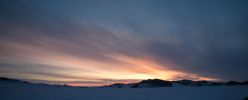The First 1000 Miles
Scandinavia - The Scenic Route
Scandinavia - Ever Northwards
Finland - farewell to Europe
St Petersburg – As we saw it
Russia – welcome to chaos
Moscow, a little piece of Fulham and onwards
Kazakhstan – into the wilderness
Kazakhstan – away from the plains
Kyrgyzstan – a nomadic life
China – a different world
Pakistan – a land of superlatives
India - Amritsar and Kashmir
India - Ladakh & Himachal Pradesh
India - Delhi
India - Rajastan & Gujurat
India - Maharastra and Goa – chasing the late monsoon
India - Madhya Pradesh to West Bengal
Bangladesh
Singapore and Malaysia
6th – 15th July
Bulgaria
Entering Bulgaria we immediately leave Turkish modernisation and sophistication behind – the three lane motorway disintegrates into a single lane, bumpy country road. Gleaming new Turkish towns are replaced by crumbling red brick villages interspersed with lush, rolling countryside.
There’s little traffic heading north but it’s impossible not to notice the exodus of European cars all heading south – from Germany, France, Belgium and Holland – it’s summer holiday time and this is evidently the European equivalent of the M5 to Cornwall.
We stop for lunch in sleepy Haskovo, a mid-sized Bulgarian town, before turning onto a country lane towards Nikolovo, a tiny Bulgarian village that’s apparently home to an English run guesthouse and campsite.
When we arrive in Nikolovo half an hour later it’s hard to believe there’s any accommodation here, at all. The village is impossibly picturesque, a muddle of quietly decomposing red brick cottages each surrounded by ancient dry stone walls enclosing abundantly stocked vegetable gardens and vineyards.
We explore every track in the village without success, before some friendly locals agree to take us to the home of an English couple living in the village – surely there can’t be more than one English couple here?
Heather and HatActually there are three. Pulling up outside one recently renovated cottage, our cheerful local guides drive off amidst a cacophony of horn beeping and hoots. The garden gate opens and Heather and Hat, a retired couple from Ipswich, peer out to see what all the noise is about.
We look rather sheepish but introduce ourselves and before we know it we’re sat in their well tended garden, enjoying a late afternoon beer and chatting about Bulgarian village life. They don’t own the guesthouse, but they’re an incredibly hospitable, salt of the earth couple. We ask how much wine they’re producing from the vines in their garden.
“’Bout hundred an’ seventy litres last year” Hat replies proudly, taking another swig from his tumbler of red. It’s a hell of a lot from your own garden, we remark. Do they sell any? “I get through ten litres a week of this stuff” Hat replies equally proudly, his husky voice coarsened by years on rollies. Luckily the local produce is so cheap, though, that they can top up their supplies and maintain a year-round Bacchanalian haze without breaking the bank. It’s an enviable lifestyle…
Leaving their humour and hospitality, we try to find Garry, owner of Tree Pigs Farm & Guesthouse, who lives at the other end of the village. His equally charming cottage and even more abundant veg garden appears deserted. But soon he appears, a stocky, cheerful fellow, dozens of tattoos escaping from his rock’n’roll vest.
Bulgarian boozing
Some British habits don’t change, wherever you are. Once again within five minutes we’re sat in the garden, beer in hand, discussing Garry’s own veg patch and his wine production – he managed 200 litres of home-made wine last year, plus 50 litres of highly potent rakia (made from the leftovers from the wine production).
Evidently, ex-pat living in this part of the world requires a tremendously strong liver. Garry certainly looks well on it.
After a jaunt to the local bar for a few rounds of Bulgarian lager, we head home and cook supper in Garry’s vine-shaded courtyard. He joins us and gives us an interesting and educated insight into life in Bulgaria – with a very low cost of living, beautiful scenery, mild climate and friendly locals, it appears to be a good spot to retire too. Plus, Garry mentions (as did Heather and Hat) – Brits abroad are still a rarity here…
The following morning, heads sore after sampling Garry’s wine and rakia, we head north, with armfuls of fresh vegetables from the garden plus a few jars of Garry’s excellent home-made pickles – they are kind hosts in these parts.
Stuck in Sofia
Unfortunately only 40 kilometres up the road our gearbox begins to play up again and once again we’re without 4th gear. We plod slowly into Plovdiv, Bulgaria’s second city, and find a decent garage (we’re in need of an oil change anyway) – but they can’t find anything substantially wrong with the transmission.
We don’t have much option but to continue, but the problem gets worse on the hilly roads outside Sofia – we stop at a service station for a think and meet a local lad with a low-loader. Sofia’s only 40km away but it’s a sensible precaution to put the car on the truck and get it to the capital, where we know there’s a Toyota garage.
€96 later and we’re deposited unceremoniously outside Sofia’s gleaming Toyota centre. Thankfully, one of the managers, Viktor, speaks English; we’re fed up with having to discuss our automotive issues in Russian.
We end up leaving the car with them for two days whilst they test everything. We still have enough time to get home by the 15th as planned and it’s more important the car gets fixed here, if it can be, than having it break completely so frustratingly close to home.
Sofia is actually a lovely city in which to spend a few unplanned nights. We take a taxi to the centre and find a rather bohemian, inexpensive hotel nestled on the fourth floor of a period townhouse in the centre. It’s perfect, except for the manageress – a 40 year old waif with a shock of black and grey hair – who’s as mad as a brush and determined to talk at us on subjects of utter inanity at all times of day and night.
After half an hour of puerile conversation, we manage to disgorge ourselves on the pretext of needing an early supper, rather guiltily leaving a softly spoken lad from Bradford to bear the brunt of her idiotic ramblings.
The city centre comprises about a dozen streets, lined with pretty, pastel tinted townhouses and wide pavements upon which dozens of relaxed and appealing restaurants and cafes have sprung up in the years since the fall of the Iron Curtain. It’s not hard to find a good place to eat; nor is it expensive.
There’s no news from Toyota the following morning so we set out for some sightseeing. There isn’t a plethora of sights – the bulbous, grey mass of the Alexander Nevsky Catherdral holds pride of place in the city – but the streets, parks and cafes are enough to keep us happily engaged whilst we wait for news on the car.
Whilst frustrating, we both agree it’s infinitely preferable to Phonsavanh in Laos, which was the last place we got stuck at the mercy of the local mechanics.
Slowly to Serbia
Finally, at lunchtime the following day, Viktor has good news. They’ve tested seemingly everything and there are no major problems – they’ve cleaned a few valves and tightened a few bolts round the turbo and the car is now running fine. He’s helpful, knowledgeable and pragmatic – more than can be said for numerous other Toyota representatives we’ve dealt with – and insists we’re good to go. Either way, we don’t have much choice. There’s nothing else they’re prepared to do and even if there was a major fault, all their parts take two weeks to arrive from Greece anyway…
So we hit the road north, towards the Serbian border, aiming to cover 400 kilometres and reach Belgrade before nightfall and make up some lost time.
All goes well for 80 kilometres before the same problem re-asserts itself – but there’s nothing we can do apart from drive the car in 3rd gear at 80km/h and continue. We work out we’ve got another 30 hours’ driving to get home if we have to continue at this speed…
The border crossing is swift but unpleasant. A smug, seedy little Serb in the drive-through immigration kiosk insists our Georgian issued Green Card is not valid in Serbia, ostensibly because we have a British car. We’d be fine, it seems, if we were French, or German, or even Italian…
So we have to cough up €100 for a month’s worth of Serbian motor insurance, despite the fact we’ll be out the other side within 24 hours. That done, a vastly grotesque and aggressive customs official barks at us to open the car up for a search, although pleasingly he soon gets bored and finds someone else to delay.
Bypassing Belgrade, crossing Croatia
We reach Belgrade’s only campsite at dusk, serenely positioned on the Danube in the outskirts of the city. The location, though, means only one thing for us when we arrive: mosquitoes. As soon as we park up we’re surrounded by a plague of them, making us wonder how all the other guests at the campsite seem to be enjoying their evening meals and refreshments so calmly. With five mosquito coils lit and a head-to-toe lathering in repellent, they begin to leave us alone and we can get on with having a beer, cooking supper and wondering how far we’ll get before our gearbox implodes.
Feeling much better for a decent night’s sleep, in the morning we swiftly reach the Croatian border and pass through without any fuss. Serbia will have to wait for another trip. What we saw of it was pleasant enough but not breathtaking – endless rolling agricultural scenery dotted with pastoral villages and dainty, turreted churches.
Inland Croatia is similar although the hills are larger, the countryside less arid and the villages more picturesque. We stop for late lunch in the capital, Zagreb, after long, slow drive through the bulk of the country. Prosperous, laid back and packed with grand squares and colourful avenues, we could easily spend far more time here, but we still need to catch up some ground before we can start to relax again.
Slovenia to Salzburg
After lunch we push on to Slovenia and can finally stop thinking about exchange rates – at long last we’ve hit the Eurozone. Sadly, it’s another country we don’t give a fair chance to. It’s incredibly beautiful, tucked in the southernmost reaches of the Alps and dotted with well kept villages and beautiful churches.We stop for the night in a campsite outside Ljubljana, the capital (at €27 our most expensive ever), visit the crystal clear and idyllically situated Lake Bled in the morning, and cross to Austria, vowing to return.
Austria passes us by in a blur of summer Alpine scenery although we do stop for lunch and a leg stretch in Salzburg – a thoroughly agreeable city of colourful baroque architecture and innumerable commemorative statues and squares devoted to its most famous son, Mozart.
Salzburg, evidently, has managed to find its way on to the US tour group circuit - meaning there are now a few more Americans, though still unable to point to Austria on a map of course, who at least now know that some ‘stiff old composer’ was born here.
Munich
In the sweltering afternoon sun we drive north through the undulating Bavarain countryside towards Munich and stop at a campsite some 30km south of the city, on the shores of Lake Starnberger, a favourite weekend retreat for the city’s residents. It is the weekend and they are here in force, proudly displaying sagging, sunburnt beer bellies to all and sundry. We delicately step over a few bodies on the way to the ‘beach’ and enjoy a refreshing and much needed swim after the days’ exertions. The car is feeling worse again this afternoon, but at least we’re now in the centre of the European car industry…
We spend the morning in Munich, deserted but for a handful of tourists and locals who’ve chosen not to head south. As we’re admiring the splendid baroque buildings we’re approached by a friendly local who gives us some tips on what we should see. We end up spending 10 minutes or so walking and chatting together.
Whilst we’re certainly used to being approached by friendly locals, this is unusual – back in Europe, this kind of thing doesn’t tend to happen. Our chaperone is neither mad, lonely or after money – just a friendly fellow. It’s refreshing, though we can’t help thinking what a rarity it is back in Western Europe.
Stuttgart
We spend the afternoon driving sedately towards Stuttgart. The gearbox won’t play again so we stop at a motorway services and decide to change the gearbox oil and start afresh with new stuff – something that should really have been done by the Toyota mechanics in Sofia. It’s a messy, awkward job, especially when by the roadside and having to collect the six or so litres of fluid in old water bottles. It comes out murky, brown and burnt – definitely a good job done.
Unfortunately it doesn’t solve the problem so we limp quietly on to Stuttgart and find a peaceful campsite in a wooded valley outside the city. The proud owner feeds us on strong local lager and a typically German ham salad (all ham, no salad); soon we collapse, contentedly, to bed in the back of the car.
Stuttgart is arguably one of the world’s great automotive centres. Home to Porsche and Mercedes (and these days no fewer than three Toyota garages), we figure this must be the place to resolve our problem once and for all. But a visit to the largest and most central garage proves futile. The helpful mechanics, immaculate in their pristine, freshly pressed white shirts, tell us that they’re not authorised gearbox specialists so they’re not even allowed to clean the inside of our gearbox (a simple job) – and even if they could, they couldn’t fit us in ‘till next week.
It’s ironic to think that, for all Europe’s wealth, sophistication and free enterprise, for us it’s actually been easier to get stuff done with the car in Asia, especially the remote places. No paperwork, no company protocols, no job-sheets or waiting lists. For now it seems, we’re as good as on our own.
Luxembourg
So we drive on, slowly, towards Luxembourg, enjoying the mountainous scenery and charming villages of the northern German Alsace region. We make it to our final new country of the trip by 5.30pm, in time for our last taste of hospitality before we reach home.
We’re staying with Michelle Decker, Catherine’s mother, with whom we made friends and spend three days with in Ulaan Baatar. Catherine’s still there, working for the UN, but has kindly arranged for us to stay at her family home in Luxembourg. It’s a hugely appreciated act of kindness, as Luxembourg is as expensive as it is beautiful.
After a wonderfully warm welcome and a much needed decent shower Michelle drives us the five minutes into the old city, where we meet Max, Catherine’s partner who is shortly to join her in UB. High spirited and laid back, Max gives us a brief ‘city tour’ before we settle down for pre-dinner drinks, waiting for the rest of the Decker family to join us for supper.
He’s Luxembougish but has spent most of his older years living abroad, for despite Luxembourg’s indisputable beauty, wealth and high living standards, he still prefers for the grit and excitement of living in some of the world’s less developed countries. He’s already spent six weeks in Mongolia with Catherine. We all agree he’ll find more day-to-day drama there…
After a fantastic supper with Max and the rest of the Decker family we sleep soundly in the most comfortable surroundings we’ve enjoyed for some time. After a relaxed morning’s sightseeing with Michelle, we leave for France, somewhat reluctantly but in high spirits.
Champagne country
We spend our penultimate night away in Epernay, parked up in the municipal campsite surrounded by dozens of Dutch and British camper vans. Trying to avoid the interminable “so where’ve you been this holiday then?” small-talk with our neighbours, we leave early the following morning for a brief tour of the Champagne region, beautifully lush at this time of year.
We track down the Maison de Ariston et Fils in Brouillet and introduce ourselves to M Ariston. Our French friends from Turkey introduced us to his excellent Brut Tradition and we’ve been determined to visit this particular champagne house on our way home to purchase some more. Mission accomplished, we leave with large smiles and two cases and drive north towards Normandy.
And so, to home…
As it always does in Normandy, it starts to rain, heavily. So heavily, in fact, that the idea of camping for our last night goes out the window. By chance, today is also Bastille Day so every single restaurant, B&B and gîte is either full, or closed. We end up in a roadside guesthouse some 10km from St Omer, just 40km from Calais. The restaurant is shut for the night, but our host kindly prepares a plateau repas for us before she too goes out for the celebrations.
Having cooled a bottle of Ariston Fils in the freezer, we find a couple of chairs and sit in the deserted hotel car park, overlooking a damp, flat vista of cornfields, and celebrate the last night of our trip. It’s not quite the last night we imagined, but unexpected and a little random, so perhaps it’s quite appropriate.
We’re nervous about crossing the Channel tomorrow, about the prospect of stepping back into a world more real and less varied than the one we’ve lived in for the past thirteen months. But we’re also hugely excited by the prospect of seeing our friends and families, and tellingly, we don’t have that end-of-holiday depression that so often accompanies the end of a trip abroad.
Well perhaps - after a year, a month and a day on the road - it’s finally time to go home.
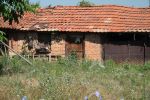
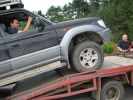
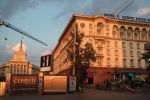
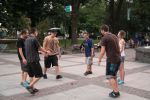
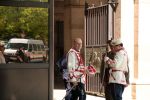
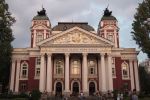

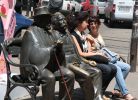

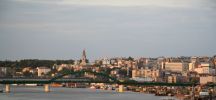
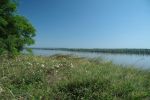
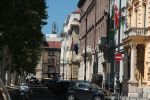
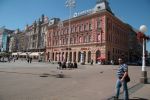
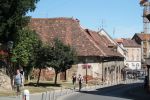
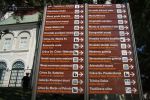

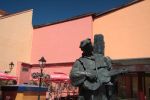

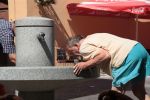
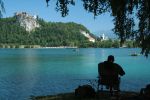
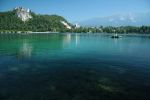
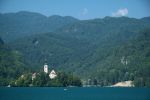
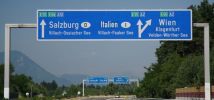
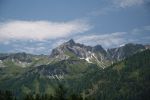

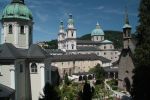
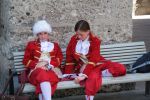
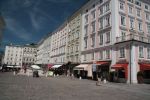






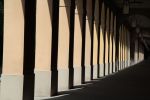
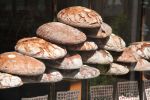
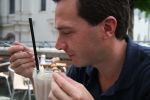
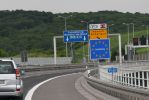
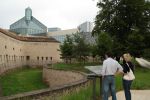
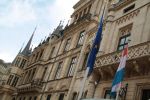
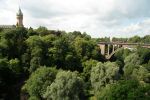

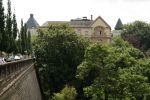

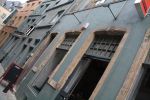
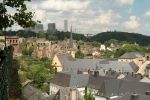
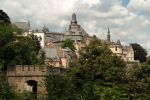
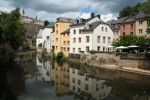
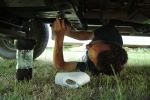
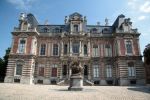
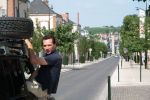

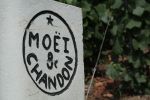
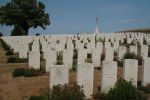





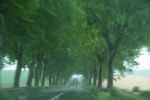
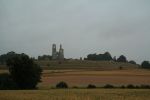
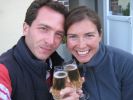
28th June – 5th July
Eastern approaches
Given that Turkey’s been trying to join the EU since 1959, it’s somewhat surprising when we’re asked to stump up $20 each for a visa at the border.
Ever diplomatic, we politely remark that the (equally ambitious) Georgians have done away with their visa requirements– but our observations fall on very deaf ears. All immigration officials are masters in the art of indifference, but these ones take passivity to a whole new level.
Other than that the crossing into Turkey is smooth, swift and uneventful; we can tell we’re closer to Europe than Asia now when a customs officer asks us if we’re carrying large quantities of “cigarettes and alcohol” rather than “guns and drugs”.
We drive west from the border, following the Black Sea coast, to Hopa. The coastline is as dramatic as it was in Georgia; the coast road sandwiched neatly between densely forested mountains above us and rocky beaches below.
From Hopa we turn inland, weaving our way along serpentine mountain roads, through Turkish tea plantations and alongside narrow gorges. Whilst it’s beautiful, we can’t believe how developed it is: towns marked as small on our map comprise battalions of high-rise blocks, spilling along the valleys in every build-able direction. Sprawling Artvin reminds us of a Chinese city whilst even the tiny back roads are in pristine condition.
Western prices
We stop for lunch at a little restaurant tucked in the woodlands off the main road and our first Turkish food is excellent. Local Alabalik fish (small Turkish trout), dolma, kebabs and olive-filled salads. But it’s not cheap; the equivalent of £15 – even here, in an eastern backwater.
Food’s not the only thing that’s expensive out here: Turkish fuel is almost the most expensive in the world. Petrol’s a whopping £1.60 / litre; diesel is a little better at £1.35 / litre but still a hell of a shock to our systems – we haven’t consistently paid more than 60 pence per litre for months!
After lunch we follow a narrow gorge southwards towards Yusafeli, our first night’s destination. A fierce river thunders through the bottom of the gorge and we’re flanked on either side by yellow rocky cliffs that rise 300 metres above us. It’s dramatic but we can’t help notice the dozens of deserted villages: a massive dam construction project is underway here and in a few years the road we’re on will be submerged beneath 100 metres of water.
The following day we push on west – Turkey is a vast country (the largest in Europe) and we’ve only 9 days to get across it. Past vast Erzerum, the high plateau of eastern Anatolia holds little for us in the way of scenery and we make the most of the new motorway, covering nearly 400km before lunch.
Oil, oil everywhere
Progress after lunch isn’t quite so smooth. Within 100km we suddenly lose 4th gear, on a slight incline, and typically – exactly halfway between two of Turkey’s large cities (Erzincan and Sivas) – in the middle of nowhere. The underside of the car looks like the Gulf of Mexico – not a good sign.
It looks like a huge leak in our gearbox somewhere, so we empty our remaining transmission fluid into the car and limp on, praying there’s enough fluid in there to prevent the gearbox grinding itself into an oily pâté.
Luckily, another 10km on we find a fuel station – being so developed here (it’s all relative!) they even sell transmission fluid at the filling stations – and can refill the box properly and carry on. Good timing, as shortly after we drive through one of the worst thunderstorms either of us have ever experienced – so much so relieved to make it through the other side without succumbing to a direct lightning strike.
After a good night’s sleep in cheerful, untouristy and pretty Sivas we head on to Cappadocia, stopping at the Toyota garage only to be told there’s nothing drastically wrong with the car. We’ve heard that before, days before our cylinder head cracked in Laos…
Captivating Cappadocia
Cappadocia is another shock to our systems. The region is deservedly Turkey’s second biggest tourist attraction behind Istanbul, but we certainly weren’t prepared for the crowds, or the caravans, or the campervans… Suddenly, our overland adventure is over and we’re firmly back into European camping holiday territory.It’s certainly not all bad though. We check into an extraordinary campsite, Kaya Camping, which for £12 per night gives you incredible views over the Göreme valley, a wonderful swimming pool, washing machines and free wi-fi… Our planned two nights turn into three, one of which is spent entirely within the ground’s confines.
When we do manage to drag ourselves away from the pool, Cappadocia is worth the effort. The scenery in the surrounding valleys is incomparable: semi-arid plateaus littered with thousands of colourful pillars and ripples of rock, formed by millions of years of erosion. Amongst these surreal canyons and clusters of natural towers, people have built their houses into the soft rock for millennia.
Entire cities, churches and cathedrals exist underground or hewn into the rock-faces. One could spend weeks here, exploring caves, grottoes and wonderful natural formations – but perhaps we’ve seen enough things recently – a day and a half is sufficient for us and the pool is calling…
Camping in style
We spend three wonderful and relaxing days here, including two memorable and drunken nights with Laurent and Thibault, two charming and like-minded French overlanders who very kindly cook us our first celebratory engagement supper and of course, being civilized and French, produce a superb bottle of champagne to accompany it…
In return, we muster up fine scrambled eggs and coffee for breakfast – much to their delight and envy. For whilst they may carry champagne, we carry a coffee percolator and a twin-hob stove…
After three days, reluctantly, we press on again, now making all haste for Istanbul.
We bypass the modern metropolis of Ankara (only the third country we’ve visited where we’ve deliberately missed the capital) and spend a night en-route on the Black Sea coast, 600 miles west of where we left it at Hopa. It looks just the same – lush mountains dropping precipitously into a clear blue sea.
Finally, officially, Europe
Driving into Istanbul, we’re swiftly reminded about European congestion, and sit in a traffic jam for an hour and a half in the outskirts.
Finally, with a feeling of achievement and excitement (as well as sadness) we cross the Bosphorus and finally return to mainland Europe – 11 ½ months after we left it, crossing the Ural River in Kazakhstan last July.
Infuriating Istanbul
Any sentimental thoughts are swiftly put on hold, though, dealing with navigational and traffic issues in Istanbul’s old city. Beautiful it may be but it’s a bitch to navigate thanks to it’s plethora of one-way systems and car-free tramlines.
Eventually we loose our patience and opt for the tramlines; Nina then manages to sweet-talk a security guard into removing some bollards from a pedestrianised road; shortly afterwards we’re parked outside the Four Seasons Hotel, where we can leave the car for free whilst we stay in an equally well located but considerably cheaper lodging across the street.
The summer holidays may have started, but Istanbul makes Cappadocia look like a veritable backwater. Istanbul’s collection of vast, bulbous mosques and piercing minarets are extraordinary sights but simultaneously an absolute scrum of inappropriately dressed, sunburnt, camera-wielding humanity. Virtually every dwelling in the charismatic old town is a boutique hotel or restaurant. There’s little to fault, but it’s a shock to our unacclimatised senses.
After two frenetic and expensive days, we drive north, along 250km of pristine, near empty motorway, to the Bulgarian border. We don’t get our passports stamped and Nina doesn’t even have to get out of the car! It must be Europe. All being well, 10 days and we’ll be home…






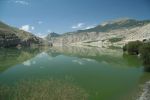

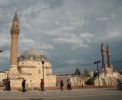





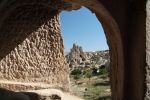

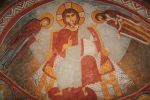




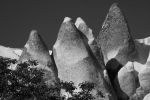


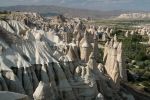




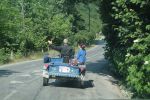
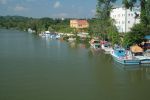
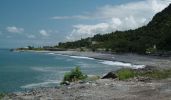










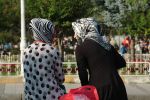












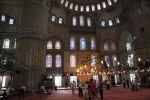
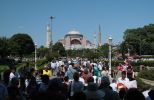




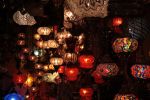
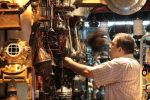


21st – 27th June
Soviet scars
We cross into Armenia from Georgia at Sadakhlo, in bright sunshine with high hopes of this beautiful yet tragic little country. For a republic supposedly trying to encourage tourism and foreign investment, it’s astonishingly expensive to drive into - $65 for four days worth of car tax – before we even drive a mile…
Within an hour of crossing we’re in the midst of a huge thunderstorm. The views of the heavily forested Debed Canyon obscured, we stop for lunch at a roadside café and wait for the weather to clear. One hour and $20 later (this country is expensive) we’re driving through scenery that is simultaneously stunning yet scarred by decades of Soviet heavy industry projects – rusting factories, crumbling apartment blocks and endless electric pylons follow the Debed River through this once majestic gorge.
We turn off the main road a couple of times, climbing dozens of switchbacks to the gently wooden plateaus that sit above the gorge, in search of some of the region’s ancient monasteries. They’re generally still intact, blackened by eight centuries of weather and now presiding over post-industrial pollution rather than pristine beauty.
We carry on up the valley, past the bleak and poverty-stricken copper mining town of Alaverdi – a ribbon of more decaying Soviet apartment blocks dominated by a vast, barely functioning smelting plant belching thick grey smoke into the gorge. This factory once employed 100,000 people – most of the town’s population – but now most of the populace sit idle amongst their dilapidated streets. It’s all rather depressing.
We spend our first night in the Vanadzor, the capital of the region and although larger than the previous towns, certainly no prettier. It starts chucking it down again so we opt for a family run B&B in the centre of town. The owner’s daughter greets us acidly; it appears we’re staying in her room so she’s confined to the living room – which despite the $25 income evidently doesn’t please her too much.
Lake Sevan
In the morning the weather’s much brighter, as are our spirits – invigorated by a decent night’s sleep. We drive southwards through relatively unspoilt countryside towards Lake Sevan, stopping in the sleepy town of Dilijan to admire some of its nearby monasteries; 12th century masterpieces of masonry and stone carving tucked away in quiet valleys covered in beech and walnut forests.
Lake Sevan is the country’s number one holiday destination – an 80km long stretch of pristine water at 2,000 metres, surrounded by fertile plains and the occasional distant snow-capped peak. The Soviets drained the lake by some 20 metres for irrigation and hydroelectric projects, revealing a number of tantalising beaches around which holiday resorts were soon built.
For sound and necessary ecological reasons, however, the lake has been slowly refilled over the past 20 years and the beaches are now covered by water again – leaving dozens of surreal beach bars, bungalows and jetties half-submerged by the waters.
The sun’s still out so we find a suitable spot for camping; a quiet lakeside picnic site overlooking the beautiful Hayravank monastery, jutting out into the lake on it’s own little peninsular. The caretaker charges us a hefty 5,000 Armenian dram ($14) for the privilege.
Crayfish and vodka
Evidently he feels guilty, as whilst we’re cooking up our supper, he wanders over with a bottle of vodka and a bag of freshly caught crayfish that he’s commandeered off some local fishermen. He kindly insists we join him for a swift shot – although as per usual there’s no such thing as a single shot.
He spends the evening with us, sharing the crayfish and proposing numerous toasts which soon put paid to the vodka. He departs briefly, only to return with three large bottles of strong local beer with which to continue the evening.
As we chat about his country, he reminisces about the “good old days” of the Soviet Union – a time when everyone had guaranteed jobs and places to live, security, and enough money to put food on the table. Armenia suffered more than most of the Soviet Satellite Republics (SSR’s) – Stalin purged or exiled over 500,000 people here – yet tellingly many people here still look back on the Soviet days as better times.
The next morning we diplomatically evade the offer of a morning vodka shot from our host; however there’s no escaping another present – a huge bin-liner full of freshly caught, live crayfish - about three kilos worth. Heaven knows what we’ll do with them… Finally, we make our way to Yerevan, the capital.
Yerevan
Despite it’s relative wealth, Yerevan is not an attractive city – dozens of avenues lined with well kept but dreary apartment blocks, and a raft of uninspiring new buildings. Like the rest of the country, it’s also phenomenally expensive.We find a B&B on the city outskirts, park the car up and get the metro into the centre. Three hours later and we’ve done all the sightseeing we want to – there’s a new cathedral that’s more impressive for its substance than its style, a recently completed 100 metre long cascade of waterfalls and gardens that runs off a hill in the centre of the city (it’s less impressive than it sounds) and dozens upon dozens of new, chic cafes that are the city’s greatest feature. Trendy Armenians hang out in these by the dozen, enjoying the balmy weather and designer cappuccinos at $4 apiece.
Fortunately Samuel, the B&B owner, agrees to cook up our mountain of crayfish for supper so we can share them with him and his family – it would take us weeks to eat them on our own. He mentions that crayfish from Sevan used to be much bigger, but over-fishing has ravaged the stocks. “But what can the fishermen do? They have to live somehow”.
Samuel is a fully qualified engineer who speaks fluent English. Over a very long and drawn out supper of beer and crayfish, he gives us a fairly damning insight into his blighted country.
Self-enrichment, government scale
The current government comprises a handful of oligarchs whose principle aim is to milk as much cash from their people as possible. Unlike numerous other countries we’ve visited where personal self-enrichment is the raison d’être for working in government, this is the first country where such self-enrichment is derived directly from local people’s own cash rather than by one-sided exploitation of local resources or similar.
Thanks to a long history of emigration, coupled with a mass exodus after the 1915 Turkish genocide (during which half a million Armenians were massacred), Armenia now has a huge diaspora population living worldwide – around eight million people, compared to just three million Armenians who live within the country.
Monopoly money
This diaspora sends back some $1.3 billion per year – around 30% of the GDP – which keeps the country’s economy artificially growing. In order to maximise their takings of this annual cash influx, the government keeps the Armenian dram artificially strong – about twice its market value – ensuring that every dollar entering the country buys less local currency.
This, coupled with effective state monopolies on every single available product in the country – from oil to rice, newspapers to mobile phones, banks to airlines – means no currency black market exists and therefore locals have no choice but to accept the poor exchange rate, and give the difference to the government. It must be the only country in the world with an artificially manipulated currency and no black market.
Samuel complains that it’s impossible for ordinary people to start businesses, thanks to heavy taxes and regulations that apply to everyone except government officials and their families. Everything imported from abroad (even a single mobile phone) requires payment of monstrous taxes – hence trapping ordinary Armenians in government-induced poverty.
Hope for the future?
Samuel reckons 90% of the country’s wealth rests with 50 families. Isn’t there anything the population can do about it? We ask.
“Not here” he says resignedly. “Armenians are not violent people. They will never choose to fight anyone, least of all their own government. We will never rebel, we just accept it and try to work harder to look after our families” Samuel’s B&B is unregistered and technically illegal – he couldn’t afford to run it if he had to the pay government taxes and registration fees. That’s why he’s left it half finished – so he can claim it’s not open whenever the numerous government inspectors randomly visit.
He too harks back to the good old days of Communism. It’s not surprising, though, given the state of the country now. Eventually, we call it a night and go to bed – its 3am – although Samuel could talk all night about his country’s misfortunes.
The following morning, we start early and drive north towards the western Georgian border. The countryside north west of Yerevan is very different to the east – arid, rolling hills covered with colourful wild flowers, yet still dotted with ugly Soviet villages.
Escapism
We stop briefly in Artvic – a particularly depressing and decrepit town en-route – to look at one last monastery before we leave. We find it, in the shabby outskirts. A couple of drunks try to relieve us of some loose change in the car park – it’s 10am and they can barely stand – but we find it hard to feel anything but sympathy for them. As we walk inside the grounds, a young girl rushes up to Nina and presents her with a big bunch of bright blue flowers, grins for a second, then dashes away shyly.Walking into the monastery, four black-robed monks start singing a psalm in a low, mournful tone. A father and daughter are the only other attendees at this intimate service, heads hung in devout reflection.
Amongst all the poverty and hopelessness we’ve seen in this country, the dereliction and the drunks outside, it’s an intensely moving moment – in this country, it seems that many people find hope only in God, or alcohol. We each light a candle, leave a donation, and slip away quietly as the monks finish their service.
Two hours later during another thunderstorm, we cross back to Georgia, having to pay another $25 in car taxes just to leave Armenia. This country really doesn’t help itself.
Good old Georgia
We both breathe a sigh of relief to be back in Georgia. Though not without its problems, the country just feels so much more alive, its people sturdier, happier, more passionate – not downtrodden and passive. We drive down the stunningly beautiful Mtkvari valley to visit the magnificent 12th century cave dwellings at Vardzia, dotted throughout a 300 metre high cliff-face above the Mtkvari River.
The next day we head to the Black Sea coast and enjoy two days relaxing in the sunshine in and around Batumi, surrounded by cheerful and occasionally drunken weekenders from Tbilisi, all making the most of the weather.
Invigorated and refreshed by more Georgian hospitality, katchapuri and of course plenty of local wine, we head to Turkey in high spirits. We can’t believe that we’re almost officially back in Europe…






























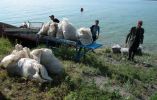




























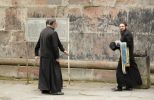






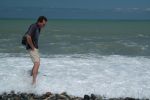
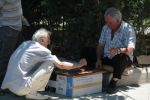
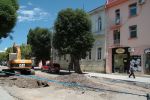
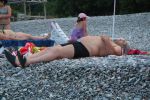
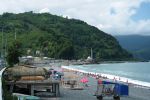
15 - 21 June
Wine country
After breezing through one of the most efficient and modern border control posts we’ve seen in Asia, we drive straight into Kakheti, Georgia’s beautiful, rustic wine country – a wide, verdant plain of vineyards enclosed by the pine and snow clad Caucasus to the north and an equally pretty, coniferous ridge of mountains to the south.
We pass through sleepy, crumbling villages, full of stately, once grand brick and stucco fronted houses each complete with long established vine-shaded courtyards. Old men sit cross-legged on rickety donkey carts, bringing in freshly cut hay from flower filled meadows. The countryside is beautiful, pastoral, and lush – it feels like what England might have looked like 100 years ago, before we covered it with things like the M4 and Swindon.
We spend our first night in the distinctly Italianate hilltop village of Signaghi - like Tuscany’s San Gimignano except with cheaper (and arguably better) wine and no tourists. Whilst looking for a B&B, Vana, a typically matronly, buxom Georgian, finds us and suggests we stay in her spare room in her neat little bungalow across a cobbled street from St George’s church, a crumbling 12th century tower jutting out from the old town walls.
Having agreed, she points us to a local bar and much as we’d hoped in this country, within three hours of crossing the border we’re sitting with a litre jug of ‘black’ Georgian table wine in front of us (cost c. £3) looking out over hundreds of square miles of vineyards and woodland in the valley beneath us.
So far, this country is everything we’d hoped it would be…
Vodka for breakfast
So it continues. We wake up the following morning, bleary eyed and sore, ultimately having demolished two litres of excellent Georgian ‘Saperavi’ and eaten only a solitary quail, a stick of pork shashlik and some aubergines wrapped with walnut paste – all delicious local specialities but not enough to soak up the booze.
Our delightful host cooks us a hearty breakfast of fried eggs, tomatoes and onions, but not before she insists on a hefty vodka shot each to start the day and toast eternal friendship between Georgia and the UK… we haven’t even had our coffee yet!
Wine tasting, Georgian style
That’s only the start though. Today we’ve set aside for a winery tour and our first stop is the highly regarded Kindz-Marauli vineyard, right in the heart of the Arazeni valley. We turn up at 11.30am; there’s no visitor centre of sorts but we understand the staff are usually happy to give impromptu tours and tastings.
Sure enough, Stevan, the burly, shaven headed security guard with Aviator sunglasses, is happy to give us a tour of the vast storage and aging vats and the modern and highly sophisticated bottling process. A tasting session is compulsory.
A Georgian wine tasting is not for the faint hearted – unlike the French (or any other nation for that matter) – each tasting sample comprises a glass filled to the brim, and the idea of not finishing your glass, or of spitting anything out, is unheard of. We start with the excellent sweet Muscat, then move through the Rieslings, Merlots and everything else.
Nina, with the excuses of (a) being a girl and (b) having to drive – (a) gives more credence to her argument – manages to evade the worst of the session, taking a swig of each and handing her glass to Charlie to finish.
Charlie has no such excuses; none would be tolerated by Stevan anyway. By 12.15am at least ten full glasses have been consumed; Stevan asks us for our favourite and we both declare the Muscat. With that, he promptly takes us back to the first vast warehouse and pours another full glass for each of us, for celebratory toasts, followed by ‘one for the road’, before insisting he takes us out for lunch at a nearby restaurant.
Liquid lunch
We don’t have much choice but to accept; we’re both really in need of food. We follow him in his little Lada Niva to the nearby town of Kvareli and park up at a local courtyard restaurant. He doesn’t bother locking his car. "Nye nada. Mafia!"
Indeed, nothing’s a problem here if you know the right people; all the local bosses are sat on the next door table and we’re introduced one-by-one. "Drink, drive, no problem!" Stevan proudly boasts in Russian.
The guy is merciless in his hospitality. He promptly orders a two litre jug of wine, initiating numerous toasts all round. Thankfully, excellent shish kebabs and fried aubergines soon arrive – as does the second two litre carafe… Nina’s allowed onto water by now but not so Charlie.
At 3.30pm, there’s an ultimatum from Charlie: "You need to find a hotel room now otherwise I’m going to sleep in the back of the car". Needless to say, Nina miraculously engineers a diplomatic retreat from Stevan (who’s insisting we continue the party at his house 20km away) and finds a decent local hotel nearby.
Charlie’s passed out cold by 4pm and remains so until the morning. Unsurprisingly, it’s a pretty quiet night for Nina…
Monasteries
Head pounding like Russian pop music, Charlie calls a halt to the wine tasting and the next day we indulge in a far safer and more pious activity, visiting the region’s innumerable ancient monasteries, all nestled in dramatic mountainside settings. Most have been refurbished and are now functioning again, having been neglected and used as warehouses during the Soviet era.
Feeling decidedly more virtuous, after a late lunch (katchapuri – ‘cheese pie’) we head west, over the densely wooded Gomberi pass, towards Tbilisi. We pass the ruined but still substantial Ujarma Castle, a mass of grey rock walls and turrets sat proudly on a forested outcrop, overlooking the fearsome Iori River nearly a kilometre below.
The scene typifies Georgian countryside: unspoilt, incredibly beautiful and dotted with endless ancient edifices that invariably enhance their surroundings.
We reach Tbilisi in the late afternoon and check into new hotel in the bustling Armenian quarter of Avlabari, east of the thundering Mtkvari River that dissects the city, and in the shadow of the vast and recently finished Tsminda Sameba Cathedral, at 80 metres high the biggest religious monument in the Caucasus and a symbol of Christianity’s massive re-emergence in post-Communist Georgia.
In bed with the Americans
In the evening we dine with the intelligent, quietly spoken and hospitable Stavros Stavrakos, working for the Greek Embassy in Tbilisi, and a handful of his Greek ex-patriate friends, generally businessmen who’ve operated in Georgia for years.
We chat about our first impressions of the country and about their long term views. We’ve been astonished at the modernity of the country’s infrastructure, the evidently expensive refurbishment works on numerous monasteries and cathedrals we’ve seen and the surprisingly good (and under-utilised) tourist infrastructure.
"Foreign aid!" declares Yanni, who’s run an air-conditioning and construction business here for 12 years. Ever since the Americans orchestrated the ousting of Eduard Shevardnadze in 2003 the new president, Saakashvilli has been "practically in bed with the Americans" according to Yanni.
The recently complete Baku-Tbilisi-Ceyhan pipeline runs straight through Georgia, supplying one million barrels of oil per day to the Turkish sea port, most destined for America. The stability of this civil war-torn country is therefore imperative to the Americans, desperate to reduce their dependence on oil from the Middle East.
Building bridges
To achieve such ends, colossal amounts of money have been pumped into the country, though as per usual virtually none of it filters beyond the higher echelons of society. Sure, the country’s roads and monasteries are being rebuilt, and $30m has just been spent on an Italian designed swanky new pedestrian bridge over the Mtkvari River in Tbilisi, but most of the country’s population still earns less than $50 per month. Lucky for them, they’re blessed with one of the world’s most fertile countries and can happily feed and drink themselves, if nothing else.
The new bridge was built with German and Japanese aid, using their own, foreign, staff. The amply funded project was chosen over a number of other candidates, most involving the construction of schools, sanitation and hospitals in more remote and impoverished regions.
Misdirected foreign aid
Throughout this trip we’ve seen dozens of examples of ignorant and misplaced foreign aid, helping no-one but the recipient governments and the foreign companies who get to spend it, or the hordes of self-satisfied NGOs living it up ‘on site’ to oversee its use. This example has to be one of the most mind-boggling so far, though.
By contrast, Yanni is working on a number of private projects to improve regional, un-trendy towns and villages. As we’ve seen in India, Laos, Mongolia and elsewhere, it is invariably the private individuals, often living in foreign countries for dozens of years, who quietly make a difference to people’s lives – rarely is it the NGO brigade and the foreign-aiders, prancing around in their gleaming white Land Cruisers.
European dreams
For Georgians, though, there may be some accidental benefits of their government’s acquiescence to foreign powers. Much to Russia’s displeasure, it is their publicly stated ambition to join both NATO and the EU.
Until neighbouring Turkey, at least, becomes a member of the EU, the latter may be a pipe dream. But for the time being, the democratically elected government is taking bold and beneficial steps to make the country more appealing to the West. Corporate and official corruption are being eradicated, foreign investment encouraged and age old problems of banditry and kidnapping have all but been removed.
Tbilisi
Tbilisi one of the most beautiful cities we’ve seen for a while – narrow backstreets packed with colourful, crumbling imperial townhouses; a plethora of ancient churches and cathedrals, snazzy new bars and boutiques (where the rest of the foreign aid gets spent) and ancient hilltop forts, all enclosed by steep, green mountains.
We spend three days here before heading north to along the Georgian Military Highway to Kazbegi on the Georgian- Chechen border, then south again to Gori, birthplace of Stalin.
A local hero
Gori is the only town in the whole of the former USSR that still glorifies Stalin – arguably one of the 20th century’s most influential rulers and prolific mass-murderers. A huge statue of the man stands in the main square, one of a handful left throughout the former USSR. The main street is named Stalin Avenue.
We spend the afternoon being taken around the town’s museum dedicated to its local hero by a stern matron who reels off a proud monologue in English, focussing firmly on the achievements of the great man, glossing over the minutiae of the gulags, the purges and the famines.
Only when we interrupt her to ask her questions does she suddenly soften up, genuinely pleased that we’re taking such an interest in her lifelong hero. One thing that strikes us is what a good looking lad the young Stalin was, wavy hair and dashing features – looking at these, it’s hard to imagine he was capable of committing such horrors.
Recent incidents
In the evening we explore the streets, looking for a decent restaurant in which to eat something other than the ubiquitous and uber-heavy katchapuri.
It’s only then we notice the bullet holes.
Every building; shops, apartments and offices, is riddled with them. Rounds are embedded in wooden doorways, metal shutters are pockmarked. Strangely, all the buildings are recently painted – yet the bullet holes are newer, so new, in fact, as to have not been plastered over (generally they’re plastered over very quickly, to help local residents forget recent horrors and move on).
A little investigation reveals that Russian tanks rolled through here as recently as late 2008, supporting the secessionist rebels in nearby South Ossetia. The border is only 15km north and the civil war regularly spilled over into the rest of Georgia.
It’s a stark reminder that despite the foreign aid and fancy bridges, so long as the issues of Abkhazian and South Ossetian independence (or otherwise) remain unresolved, this beautiful, hospitable little country is never far from civil war. And while Russia continues to support the secessionist regions, Georgia hasn’t got a hope of reclaiming its territories and re-housing some 400,000 Georgian refugees still holed up throughout the country.
A local, somewhat retarded and his left arm crippled, wanders past our bar. He’s got a handgun tucked into the back of his trousers. No-one but us seems to notice, or care. We finish our beers a little more nervously and make for an early bed, wondering what Armenia might hold in the morning…






























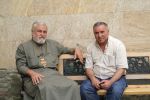





























5th – 14th June
Stamping in
On the edge of the vast Karakum desert, the Uzbek – Turkmen border point at Farab lies sweltering amidst nothing but oppressive and dusty heat. Luckily it’s easier to get out of Uzbekistan than it was to get in; Turkmenistan however, as might be expected of one of the world’s most secretive countries, takes a little longer.
We meet Maksat, our compulsory guide, at the border. The government still hasn’t got over its paranoia concerning foreign tourists since the attempted assassination of former president Sapurmat Niyazov (aka Turkmenbashi) – blamed on foreigners – and independent travel is severely limited.
27 years old, stoutly built with short cropped dark hair and a permanently cheeky expression, Maksat as a guide is everything that Chinese Queenie wasn’t. He’s on time, for a start, and he’s already filled in our customs declaration forms.
37 stamps, 10 certificates, 0 bribes and 2 hours later, we’re on our way into the Karakum desert, crossing the vast Amu-Darya (Oxus) River for a third and final time. Turkmenistan is 80% desert and one of the world’s driest countries – in the middle of the Karakum it may only rain significantly once every ten years.
Merv’s remains
There’s little scenery to slow us en-route to Merv, Turkmenistan’s ancient Silk Road city and its finest archaeological site. We arrive at 5pm, it’s still a ferocious 44°C and the wind feels like a hairdryer on full blast.
Merv is a vast collection of mud and brick ruins, once much larger than Samarkand or Bukhara but now being gradually lost to the desert. Covering an area of five square kilometres, we drive along dusty tracks, admiring the forlorn remains of what was once one of the largest cities in the world. In 1221, Genghis Khan’s hordes sacked the city following an ignored ultimatum and all bar 400 of its 300,000 inhabitants were massacred.
Model diplomacy
Our hotel in Russian Mary is subtly camouflaged amongst an enormous Turkish – Iranian truck stop. We spend the evening chatting with Maksat, consuming numerous vodka shots and excellent shashlik. Maksat is hugely likeable, as well as being encyclopaedic on his country’s history and an excellent decision maker, thanks to a seven year stint in the Turkmen army. We ask him what like was like under Turkmenbashi, one of the world’s most secretive, narcissistic and oppressive dictators, who died suddenly in 2006.
“In Turkmenistan it is a sin to speak ill of the dead – so all I will say is ‘no comment’” he parries diplomatically. “So were you sad when he died?” Charlie asks. “No. I wasn’t. Some people were, but not many”.
Ashgabat - the ‘White City’
The following morning we drive on, six hours and 400km, to Ashgabat the capital. Turkmenistan has the fourth largest reserves of natural gas in the world and the new government is working hard to open up the country to foreign investment. Despite most of the population still living in economic poverty (very different from material poverty) the country’s infrastructure is good.
Arriving in the capital, we can hardly believe our eyes. The city is one huge monument to the megalomania of Turkmenbashi. Golden statues and busts sprout forth from innumerable pinnacles whilst immaculate marble clad apartment blocks, office towers and hotels dominate a totally contrived landscape. The ordinary population is mostly banished to the Soviet era suburbs that until recently were regularly bulldozed to make way for new parks or buildings deifying the president. Shops, too, are a rarity in the city centre - considered ‘untidy’, they are generally confined to the margins.
We’re booked into the Hotel Aziya, one of dozens of new, marble clad monsters that line a hotel dominated avenue to the south of the city. Whilst seemingly vast from the outside, our hotel only has ten rooms – as do most of the other show pony hotels on this strip.
We spend two days in Ashgabat, driving around (it’s far too hot to walk anywhere) constantly open-mouthed at the cult of personality that drove such an egotistical building craze.
Trouble with the PYGGs
Moving on, we drive 600km north-west to the port city of Krasnovodsk (renamed Turkmenbashi in 1993) where we need to catch the ferry across the Caspian Sea to Baku in Azerbaijan.
Once again there’s little to stop for on the journey. Unfortunately the scenery being what it is, Charlie tries to race through and gets stopped twice by the local police (who’s acronym here is ‘PYGG’).
Amazingly, on both occasions he gets off – a first in an ex-Soviet country. Since 2006 the new president, Berdimuhamedov, has initiated numerous positive reforms in this country, including a massive crackdown on corruption. Notably, we come across absolutely no hint of corruption in this country whatsoever – a first since China.
Turkmenbashi
The Turkmenbashi – Baku ferry carries train freight and has no schedule. The five ships only leave port when they are full and, since there are only two rail berths in each port, often get held up for days at sea waiting for a preceding ferry to fill up and vacate its berth.
We arrive in to Turkmenbashi at 6pm, and head straight to the docks. Maksat’s got a friend at the cash-desk who he’s been calling for inside information – all important in this opaque and unreliable world. The latest is that the one ferry in port doesn’t have a load – and there’s no clue as to when one may arrive. Additionally, if a ferry agrees to carry a ‘wet’ load – i.e. oil – then no passengers are allowed on board anyway. We’re heartened by the fact that they’ve at least heard of health and safety out here.
Some instinct tells Maksat that we’ll be on our way tomorrow– we’ve no idea why, but we’re not so fussed. Turkmenbashi is a surprisingly nice place to hang out – a fresh sea breeze, picturesque pastel coloured imperial buildings, bountiful markets, clean beaches and the deep turquoise clarity of the Caspian. We could spend days here happily, if we had too…
BBQ on the beach
Not going anywhere for a while, we buy some fresh sturgeon, vegetables and beer in the market, and then head down to the beach. Maksat grabs some vodka en-route and we enjoy one of our most truly memorable nights of our entire trip – great company, wonderful freshly cooked food and incredible views out across the Caspian.
Numerous toasts are drunk to and we gossip until the sun sets at 9.30, enjoying the cool sea breeze coming off the bay. We go to bed contented - yet quite sad that tonight could be our last night in Central Asia.
Ferry across the Caspian
So it proves to be. By 10 the next morning a dry freight load has arrived for the Dagistan ferry and an hour later we can start the customs and immigration process. Thankfully Maksat guides us through the numerous channels and ensure we’re loaded on the boat by 2pm, before the trains are rolled on (essential as there’s no space otherwise!)
Over the last few weeks we’ve heard dozens of horror stories about this crossing – of massive corruption, cockroaches, days of delays out at sea. We spend fourteen perfectly pleasant hours on board, chatting to the crew, playing nard (an Azeri form of backgammon) with the local Azeri truckers and sleeping in our surprisingly clean and quiet cabin. We really must be the fortunate ones.
Baku’s immigration authorities appear to be as straight and disciplined as their Turkmen counterparts – two hours after we dock in Baku, the trains are rolled off and we drive on to dry land. Really, really amazing luck.
Bring on Baku
Baku is a big, pleasant surprise for us. Its reputation as the world’s most polluted city may have been deserved once but instead of driving into a grim, oil infested and stinky city we find incredible architecture, beautiful (and clean) sea front promenades, an immaculately restored and atmospheric old town and a plethora of trendy new bars and restaurants.
This is Baku’s second oil boom (thanks to the recently completed Baku-Ceyhan pipeline) and it’s receiving a phenomenal facelift – locals and ex-pats we talk to complain it only runs skin-deep but as far as we’re concerned, they’ve done a great job. New classical sandstone columns rub shoulders with Georgian style imperial mansions whilst trendy City types quaff Sancerre in outdoor restaurants on cobbled streets. At face value, there’s little not to like.
The ‘A’ word
We spend a couple of days in Baku, enjoying the civilization, great food and culture whilst simultaneously evading questions about our onward itinerary. We’re off to Georgia next - which is no problem - but after that we’re heading to Armenia – a word that causes a violent reaction from every Azeri we meet.
The two countries are technically still at war over the Armenian-dominated Nagorno-Karabakh region, thanks to years of Russian ‘divide and rule’ meddling in the 1990’s. We never manage a conversation to get a local’s perspective on the 1994 war and the current situation, so strong are their revulsions.
Oil fields
Leaving Baku, we head north east to the Abseron Peninsula and Artyom Island – supposedly Azerbaijan’s worst polluted areas. Although there are countless oil nodding donkeys and derricks in the north, things do grow here: there are plentiful greenhouses, olive groves and pine copses, all adding colour and life to the dusty plains.
Locals even frequent a beach resort on Abseron’s tantalising cobalt-blue northern coast. The ‘James Bond’ oil field (of The World is Not Enough fame) lies only 5km south of Baku’s centre – another recipient of a government clean up job.
Into the hills
Azerbaijan’s landscape is incredibly diverse. Heading inland and west, the desert yellows soon blend into golden wheat praires and then endless green meadows and rocky hillsides covered with trees. Following the Girdimançay River up to Lahic off the main road, the river valley flattens out, revealing orchards on the lower reaches of the hills, lush summer pastures at the top and dense woodland clinging everywhere in between.
Lahic is a town that time seems to have forgotten; coppersmiths beating samovars (ancient water heating vessels), delicate vases or bracelets into shape then chiselling ornate patterns in their workshops that flank the town’s only street.
After Lahic’s idyllic countryside, we continue west to Kiş (pr. Kish) for another night of the same. Kiş nestles between precipitous forests; like other Caucasian towns, every house has a generous and well tended garden. Here the main attraction is the elegant, 12th century Caucasian Albanian church in the centre. Nothing to do with the modern day country of Albania you understand – maybe that’s why the Azeris are only too happen to mention that this was the Albanian’s church once, whilst acidly noting the ‘direct Armenianization effects’ occurred when the Armenians were in town.
We are so pleasantly surprised by this country – having expected seriously corrupt officials and plain, deserted landscapes, it’s a shame our visas won’t allow us longer to explore other unexpected delights. Every Azeri we meet is kind, generous and hospitable and we’re thankful yet again for knowing a little Russian to converse.
Countering corruption
One thing we’ve noticed over the past few months is just how much corruption seems to be talked up in this part of the world, especially by individuals of adjoining countries, eager to talk their neighbours down.
Bold words, but in our experience, the efforts of some former Soviet republics do seem to be beginning to pay off, on the surface at least. We’re hoping the post-Shevardnadze government in Georgia is doing the same…
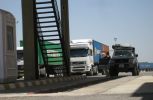
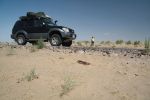






































































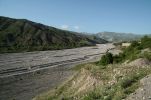
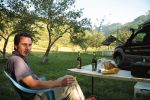
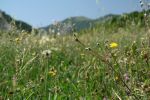

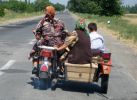
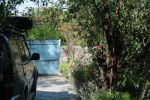
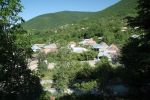
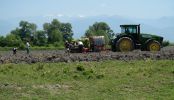
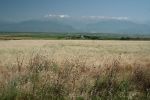
23rd May – 4th June
Border disputes
The supposedly difficult and often closed border between Tajikistan and Uzbekistan at Oybek turned out to be open, which pleased us greatly, arriving there at two in the afternoon after a slower than expected drive through northern Tajikistan.
Things were really looking up when we were through the Tajik side within 45 minutes, almost without mishap. As we advanced slowly towards the huge, metal (and shut) gates of Uzbekistan, we started to wonder if the Uzbeks would make up for all this ease.
They do, in spades. Having inched through the disinfectant trough and up to the gates, a bored looking Uzbek official walks up to the gates and without even considering opening them, informs us with raised, crossed forearms that because we have a right hand drive car, we’re not coming in. End of story.
Before we have a chance to even respond, he’s walking back to his hut; the gates between us remain steadfastly shut.
Patience is a virtue
Hmm. Not an ideal situation, given that we’ve just been stamped out of Tajikistan on our single entry visa. We sit tight, enjoy the sunshine, casually inform another border guard of our predicament (and the fact that we’re prepared to just sit here and wait until they let us in) and wonder what time we’ll arrive in Tashkent tonight.
Twenty minutes later, there’s action: another guard drives off to speak to a superior somewhere. Ten minutes later, he’s back; all is OK and we’re waved through to begin the arduous formalities. Five hours and thirty minutes later, after another round of inexplicable bureaucracy and a sniffer-dog (literally) through the car for the first time (he takes quite an interest in the contents of our fridge!) we’re through and wearily on our way to Tashkent.
Tashkent
Tashkent is a busy, sprawling city – the largest in Central Asia and the 4th largest in the former USSR. Over the past 2000 years it has enjoyed numerous eras of prosperity as a major Silk Road city and has been seized by Arabs, razed by Genghis Khan, rebuilt by Timur, conquered by the Tsarists and flattened by a massive earthquake in 1966.
As a result not much of its rich history remains in physical form and much of the new building serves to glorify the current regime under President Karimov, a paranoid totalitarian even by Central Asian standards.
We were expecting to find another ex-Soviet conglomeration of decaying concrete; in fact we drove into a lively, cosmopolitan city of shady avenues, plush new squares, blossoming private hotels and surprisingly varied districts. We were only staying a day or two to get an Azerbaijan visa, but could have stayed longer.
Vegetable oil
As soon as we’d crossed the border at Oybek, it became apparent that getting diesel in Uzbekistan might be tricky. Most of the country’s buses and trucks now run on propane gas, whilst most of the country’s diesel is exported to Russia and Kazakhstan.
We needed to fill up in Tashkent before heading south, 300km, to Samarkand. Despite two hours of searching, it proved totally impossible: Tashkent had not had diesel for months. Our two jerry cans were full, giving us 40 litres of diesel; coupled with the eight or so litres left in our tank we had a range of about 230km.
Luckily, these wonderful diesel engines run very happily on vegetable oil, so giving up our search for diesel, we find a small supermarket on the outskirts of the city and clean the totally bemused shopkeepers out of vegetable oil: 30 litres in small plastic bottles and enough to reach Samarkand!
The road to Samarkand
Relieved to be on the way, we set off south, following a dog-leg detour away from the main highway which runs straight through 30km of Kazakhstan (such are the Stalinist-era jigsaw piece borders in this region that you can drive in a straight line north-east from Tajikistan and cross four countries in 50 kilometres).
Samarkand is a long awaited destination – one of our most eagerly anticipated stops of the whole trip. Charlie’s also been hit with a decent dose of food poisoning (the first of our entire trip) so we’re hoping it’ll serve as a good convalescing spot too. We’re both exhausted, the rigours of four weeks of difficult travel through Kyrgyzstan and Tajikistan finally catching up with us. Five days in one spot is definitely needed.
Despite our weary states, we couldn’t not be bowled over by Samarkand’s extraordinary monuments, built during the 14th century by Timur (Tamerlane) and financed by the spoils of war. Timur was arguably the world’s most barbaric warlord, but his love of architectural beauty has left a far longer lasting impression on the world.
Samarkand’s Registan, a three sided ensemble of vast archways covered in exquisite geometric patterns of azure, cobalt and yellow glazed tile work (majolica) must be one of the world’s finest pieces of architecture.
Silk Road sterility
Five days here gives us plenty of opportunity to recover and take in the city’s sights. Many of Samarkand’s mosques, madrassas and mausoleums have recently been restored, somewhat controversially, although having never seen them previously it’s hard to find fault with the restoration work.
The city’s centre has also undergone a huge Karimov-style beautification process too, involving the forced demolition of large swathes of the old town with its mud brick houses and dusty narrow lanes. These areas have been replaced by heavily manicured and irrigated parks, fountains and pedestrianised streets full of boutique souvenir shops aimed at the numerous tour groups that now pass through.
Whilst pleasant enough, it’s all rather sterile. Samarkand feels a bit like a theme park, its glorious monuments rising out of the immaculate parks without a hair out of place. There’s none of the bustle, the dust, the mystery or the squalor that you might expect from such a historic Silk Road city.
Some things never change
Perhaps the most genuine, untouched part of the city revolves around the police who patrol the sights, checking tickets. Uzbek police are notoriously corrupt but in recent years have been told to be nice to foreigners (we don’t get a single fine in the country, despite having a right hand drive car and tinted windows).
The green uniformed militzia who patrol the Registan are far more interested in offering us clandestine tours up the minarets for a 2,000 sum (70p) backhander; amazingly they even offer to change money on the black market rate (2,200 sum as opposed to 1,550 sum to the dollar) – wonders will never cease!
Before we entered Samarkand we’d managed to find a solitary fuel station with diesel, meaning we’ve now got enough to exit the country, provided we drive straight to Bukhara and on to the border with no diversions.
Bukhara
Bukhara is another 260km west, through nothing but semi-desert and irrigated prairies of cotton seedlings disappearing over the horizon. There’s very little in the Uzbek countryside to hold us up; no photo opportunities apart from an ominously decrepit looking Soviet nuclear power plant half way, where we don’t linger.
Bukhara is refreshingly different from Samarkand. A former independent khanate and important Silk Road city of its own, Bukhara still has a ‘lived in’ feel; its ancient alleyways still wind through the centre, its principle sights are enjoyed and used by locals and tourists alike. Much of it has still had a facelift recently but it is definitely still a living city.
We spend two days here, enjoying the ambience and socialising – we meet our first British tourists for months, including Ed and Hattie, two Londoners who are just setting off to cycle through Central Asia for two months – literally the only other British overlanders we’ve met on the whole trip. It seems like the days of intrepid British adventurers are over – we’ve met numerous French, Swiss, German, Austrian and even Italians driving, biking or cycling through remote corners of the world, but till now, not a single Brit…
The final khanate
It’s inconceivable to leave Uzbekistan without a detour to Khiva, the most remote of the Central Asia’s independent khanates, 400km to the north in the depths of the Karakum desert. We agree with our friendly guesthouse owner to leave the car on the street outside (where it’s causing quite a stir amongst locals and tourists alike) and hop in a local share-taxi for the seven hour journey north.
The road follows the Amu-Darya (Oxus) River on its path north to the Aral Sea. We cross this mighty river at Urgench, just short of Khiva – here it is still half a mile wide and flowing fast – it’s inconceivable that so much water is bled from the river over its final 400 or so kilometres to the Aral Sea that when it finally reaches the Sea it is little more than a trickle. But then, with the amount of cotton we’ve seen growing beside the road from Bukhara, we shouldn’t be surprised.
Khiva is an ancient walled city, fully intact. Once again it's in immaculate condition; critics say almost too much so and that is has a film set feel. Yet we fell in love with the place, wandering through its ancient mud brick alleyways and admiring the breathtaking turquoise majolica of its palaces, madrassas and minarets. Whilst we’re here, its National Children’s Day – a major public holiday – and the city is teeming with locals; the women dressed in the multicoloured velvet shawls and the men wearing their ubiquitous black patterned skull caps. They’re ambling, drinking, socialising, admiring their heritage – and generally giving the place some welcome vitality.
After two days we find another share-taxi to deliver us back to Buhkara, where we find our car, safely where we left her, untouched apart from the removal of all of the dust caps on our tyres (this is a regular occurrence, the sort of petty theft we are more than happy to put up with!).
We spend our final few days in Bukhara wandering the bazaars, admiring the amazingly skillful Uzbek handiwork - and refreshingly - the embroiderers, copper beaters and painters all still producing their creations next to their stalls. For once, it seems, traditional skills haven’t been lost to China.
We’re sorry to leave Uzbekistan behind – it’s arguably the easiest and most rewarding of the Central Asian countries to travel in – notwithstanding the almost complete lack of scenery. Sure enough, the tour groups have already begun to cotton onto this, but don’t let that put you off…







































































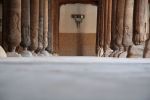



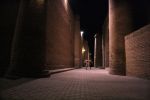




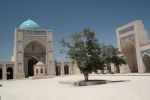

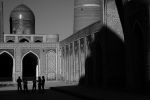
11th – 23rd May
The end of the world, again
Sary-Tash is a remote Kyrgyz village where the mountain road splits – east to China, south to Tajikistan. We passed through here last August, en-route to China – it was pretty miserable then, in the height of summer.
This time, in May, it’s even worse. Dark, menacing clouds and frequent hailstorms obscure the road leading south through the immense snow-capped Pamirs to Tajikistan.
All up, it’s not an appealing prospect to be leaving this last, bleak, point of civilization and head south on the Pamir Highway – the highest average altitude road in the world.
Nestled in a rocky, snow covered valley at the base of the 4,282m Kizyl-Art Pass, the Kyrgyz border post feels like the remotest border point on earth. Certainly not a place we’re expecting to see foreigners.
Hitching in no-man’s land
Having stamped us out of the country, though, the border officials tell us there’s an Australian hiker stuck in no-man’s land a kilometre on, waiting for a lift. We try to imagine what sort of tourist would knowingly find himself stranded within the 21km of no-man’s land between the two isolated borders…
As we pull up to a solitary Kyrgyz farmhouse, an excited, bearded and bespectacled Westerner, in walking boots and a big jacket, springs from the house and walks towards us. No wonder John’s surprised to see us, he’s been here for a day and a half waiting for a lift of any description – the fuel shortage in southern Kyrgyzstan has decimated nearly all the border traffic.
“You need a lift? Hop in!” Soon John plus rucksack are loaded into the back of the car. We begin climbing over the pass to the even more remote Tajik border, consisting of a barrier and an assortment of converted fuel tanks and shipping containers. We can’t help wondering how much these officials have annoyed their boss to get posted up here…
It’s an arduous, two hour process completing passport control, customs, insurance, route sanctioning and payments for other forms that we still don’t understand.
The Pamir Highway
Finally, we’re driving south towards Karakol through the first of many sweeping high valleys: rocky plateaus at over 4,000m, where nothing lives except tenacious mountain scrub, bright orange and very furry marmot-style creatures, plus a handful of eagles soaring overhead.
We see no-one, barring a solitary Chinese border guard, manning a watch tower beyond the double barbed wire fence demarcating the buffer zone that runs parallel to the road. Now what this poor soul’s done to offend his boss, we can’t even begin to imagine.
We reach Karakol in time for a late lunch of manti (local dumplings). It’s not hard to find a homestay offering food: the village consists of about two dozen mud brick houses perched on the edge of a magnificent (and still frozen) mountain lake; one has “HOMESTAY” written across its walls in bright turquoise paint. Even at this time of year it’s hellish cold so we push on to Murghab, the region’s administrative capital (and hopefully a little more civilization) some 150km further south.
The scenery doesn’t change much. These valleys’ austerity is matched only by their remoteness - encircled by lifeless, rocky and snow-capped mountains. The Highway is asphalt in places, gravel in others – but this Soviet-built military road has subsided so much it resembles a rollercoaster more than a road.
Great Game country
In the morning we need to register before going anywhere. This region, Gorno-Badakhshan Autonomous Oblast (GBAO), is highly politically sensitive, sharing vast, remote and un-patrolled borders with Kyrgyzstan, China and Afghanistan – ‘Great Game’ country at its finest. We also need to find diesel – the only proper fuel station here ran out long ago thanks to the Kyrgyz fuel shortage.Luckily, our homestay host knows ‘a man’– it costs nearly a pound a litre and comes in small plastic bottles. Our engine sounds particularly grumpy thanks to the combination of cold, altitude and poor fuel but there’s not much we can do about it here apart from press on.
So press on we do, leaving John to do some high altitude trekking. Another day of careful driving through similarly bleak and remote scenery sees us reach some delightful hot springs near Jelandy, where we have a much needed soak and a scrub.
Another 200km the following day and we reach Khorog, officially the end of the Pamir Highway. Finally we can feast our eyes on trees, abundant vegetation (courtesy of Aga Khan Foundation initiated irrigation canals), a pretty river and a well-stocked town.
The Pamir Highway itself is neither long, challenging, or blessed with stunning scenery, but it is incredibly remote and it’s a relief to have made it through without any problems.
We spend a couple of nights in Khorog, catching up on sleep and admiring the view down the valley into Afghanistan. The Afghani consulate here issues tourist visas on the spot for $50 – the temptation to nip across the border is considerable (especially as Badakshan, this part of Afghanistan, is so remote as to be safe) – but we don’t have multi-entry Tajik visas so sadly it’s not viable.
The Afghan market at Ishkashim
180km further south there’s a cross-border market between Afghanistan and Tajikistan held every other Saturday. By sheer fluke our timing’s spot on so we head south to have a look, picking up more local hitch-hikers as we go (there is virtually no public transport here so for 90% of the time in the Pamirs we’ve got a local on board).
The market sits on an island astride the Panj (Upper Oxus) River in a beautiful, fertile valley; a rocky stretch of no-man’s land between the two countries. Security is tight – we surrender our passports to enter and dozens of armed soldiers from both sides watch over the bazaar.
The goods aren’t interesting - mainly Chinese utilitarian plastic, but the faces are extraordinary. We’ve never seen such a mix of peoples. Sun-darkened Afghans wearing traditional koi hats rub shoulders with European-looking Hunzas from Pakistan; Turkic, European and Mongol features swarm through the Tajik contingent, a handful of Russians and a couple of Indian looking gentleman complete a cosmopolitan mix.
It’s a fascinating place to enjoy a cup of tea, some plov, and people watch under the ferocious midday sun.
The Wakhan Valley
We leave the market and head east, following the river and the Afghan border to our south. We spot John at the side of the road again – patiently waiting for a lift from anyone – it’s a happy reunion and soon he’s once again reclining, Nero-esque on our ‘bed’ in the back.
Pretty mud-brick villages come and go on both sides of the valley. The Wakhan is punctuated with 3rd century mud and stone forts – some still used by the Tajik military. Evidently this has been a sensitive frontier long before the days of Hayward, Younghusband and the like.
It’s hard to imagine how much strategic importance was placed on the Pamirs by both the Russians and the British during the latter days of the Great Game – even harder to comprehend how tough these clandestine explorers must have been, to reconnoitre these mountains in disguise, on foot or horseback, with little or no back up and often during ferocious winters. It feels arduous enough doing it in a Land Cruiser!
Abandoned Gorno-Badakhshan
We spend the night in Yamg, at the homestay of Aybek, a Pamiri scholar whose grandfather was a local mystic who introduced Sufism to the area. Like so many other Pamiris we’ve spoken to in GBAO, he tells us that the Tajik government has virtually no interest in this part of the country.
The entire Pamir region from the Chinese border to Khorog is considered economically worthless (in fairness, it’s not hard to see why) and any attempts at mining, or bringing other forms of self-dependency to the area vanished when the USSR collapsed in 1991. Aybek’s sons work in Russia where they can earn $600 per month, whereas the average Pamiri salary is just $50 per month.
It’s all downhill from here…
Heavy rain overnight (therefore snow at higher altitudes) and fierce wind this morning means we head further east towards Khargush with some trepidation. The Khargush Pass, at 4,300 metres, doesn’t sound enticing (apparently it wasn’t passable a fortnight ago) but emboldened by John, we decide to give it a go.
From Yamg the road follows the Panj River for another 80km east, winding tortuously around ravines and traversing landslide prone cliffs, before levelling out in a high valley below Khargush.
Khargush must be one of the country’s most remote military outposts; a bored soldier takes 15 minutes to register our passports before shyly asking for a cigarette. Although armed, apparently the army cannot afford to supply its soldiers around here with ammunition…
Incredibly the pass itself is a rain shadow, so there’s no snow to be seen! This is our final pass over 4,000 metres on the whole trip, so it’s downhill all the way home. We complete our southern loop by resting up in Khorog for another few days before heading northwest to Dushanbe.
High road, or the low road?
On the morning we leave, though, there’s some bad news – Sayeed, our guesthouse owner informs us there’s been a huge landslide on the northern Khorog – Dushanbe road, blocking it, possibly for several weeks. We’ve already heard that the southern road has been shut for a month or so thanks to a collapsed bridge.
We figure that the country can’t afford to have both roads blocked for long – Sayeed agrees. So still in the company of the ever amusing and kind-hearted John, we set out for Kalaikum, the halfway point to Dushanbe and the point at which the northern and southern roads split.
Afghanistan
The road is beautiful yet terrible – we’re still following the Panj River with Afghanistan the other side. We learn more about Afghanistan today than Tajikistan, the villages are so close.
There’s a tiny, gravity defying donkey track on the Afghan side that doggedly follows the river the whole way, picking its way through rock-falls and clinging to the sides of huge, sheer cliffs. The track links a network of otherwise isolated Afghan villages that consist of mud-brick houses, poplar trees and irrigation channels, immaculately tiered crops of barley and wheat and small pastures shaded by apricot trees.
There are no telegraph or electric lines and everything must arrive or leave by donkey. It must be a peaceful, simple yet incredibly isolated life here – cut off from the rest of the country by vast mountains and unable to cross the river to Tajikistan.
We reach Kalaikum at 6pm, knackered, and having found accommodation enjoy a well earned beer and plov at the village’s only restaurant, overlooking a thundering mountain stream that joins the dusty brown Panj 50 metres downstream.
Bordering on engagement
Later on, we go for a walk to admire the scenery – the confluence of these two fast flowing rivers, surrounded by vast, green mountains on each side, the pastoral village behind us and the perennially fascinating yet inaccessible Afghanistan in front of us.
It’s a suitably memorable spot. So memorable, in fact, that Charlie decides it’s the perfect spot to ask Nina to marry him – he’s been waiting for the right spot ever since asking Roger (Nina’s father) back in Hanoi in December if he could have his daughter’s hand in marriage…
We’re both, obviously, elated – but incommunicado until we reach Dushanbe, whenever that might be…
Luckily, John is on hand to share our celebrations; we drag him out of bed and head back to the restaurant to celebrate with the only booze on offer – Baltika “9” – very strong Russian lager! It’s suitably apt, though, and John is an excellent companion to celebrate with. Which is good, really, given tonight we’re all sleeping (in single beds) in the same room in the homestay!
Ironically the next day is our longest day’s drive of the entire trip so far, and any thoughts of a cruisy ride into Dushanbe to continue the celebrations soon fade.
Pick ups, tows and mudslides
At 8am, the police at the road junction direct us south. It seems the northern road will be out for several weeks and the downed bridge is no longer much of a problem…
The first 80km is bliss, but immediately deteriorates where a recent NGO road project finishes. Shortly after, we get flagged down by a new Mitsubishi pick-up. We’re greeted by fluent American English. “Do you guys speak English?”
Aziz is in his 30’s, tall, stocky with short cropped hair. He’s high up in the Ministry of Internal Affairs, but like all of his government colleagues has a business on the side to make half-decent money.
Gratefully, they borrow our jack and spanners to change their punctured tyre (they don’t have their own…), and kindly promise us a meal out in Dushanbe. Aziz also gives us his number, telling us to call him should we have any problems with the police – it’s always nice to have some immunity!
Half an hour later and we have to tow them up a hill as their engine’s playing up. As they’ve got fuel injector issues, can we shadow them until the next town, Kulob?
We’ve now been offered accommodation for tonight as well – besides – we know how much it means to have assistance when your car’s playing up and you’re somewhere remote. We follow them at a snail’s pace for another 100km, towing them here and there, as well as towing a minibus out of a mudslide. Glad we can be the Samaritans for a change!
Finally, at 6pm Aziz hops in with us at Kulob, leaving his pals to sort out the car. Despite the non-stop, deafening American-influenced trash (tellingly, he’s barely even heard of most parts of GBAO), to his credit, he gets us through the numerous road blocks swiftly and without incident (our tinted windows are technically illegal here).
It’s 11pm before we say our farewells to Aziz and arrive at our accommodation – a swanky, out-of-town resort for wealthy Tajiks, 8km north of the capital. The three of us unwind over a beer by the pool before going to bed, still bewildered by our long, random day…
Finally, running water
We move into Dushanbe proper the following day, not wanting to overstay our welcome with Aziz. The capital, with its dilapidated pastel-coloured buildings and tree-lined avenues, is the perfect place to do very little, except relax and start the process of telling friends and family our news. We don’t even take a single photo of the city!
We stay in a homely guesthouse enjoying the company of our now old friend John, the hilariously acerbic Phillipe (a French photographer) and Jim and Thelma, a kindly Northern Irish couple. We take it in turns to cook supper each night, drink plenty of beer and enjoy the novelty of permanent running water (our last running water was in Bishkek, over three weeks ago).
Suitably refreshed, we drive north, overnighting in Istaravshan before heading for the difficult and often closed Tajik-Uzbek border.


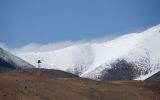




































































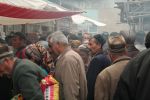




2nd – 10th May
After the revolution
On April 7th, after months of mounting tension fuelled by increasingly blatant presidential corruption, Kyrgyzstan suffered a(nother) bloody political coup, leaving 85 people dead in the capital, the president ousted, the interior minister fighting for his life and the country in a brief state of chaos.
In Kazakhstan it’s tricky to get accurate details about the coup and current state of affairs, especially from locals, who thrive on exaggerated stories of chaos in their neighbouring country. Reliability comes from Mike, the British Honorary Consul in Bishkek – who says all is now calm although only the principle Almaty–Bishkek border crossing is open.
Closed – or open?
From the Charyn Canyon in eastern Kazakhstan it’s a days drive back to the principal border, whilst we’re only a few hours from the smaller, remote and supposedly closed border post at Karkara. It’s worth a gamble.
Today the Karkara valley, usually a beautiful, sweeping plain between the Ketpen Jotasi and northern Tien Shan mountain ranges, is a misty, windswept and bitter plain and a thoroughly miserable place to cross a border.
It’s certainly basic. The Kyrgyz border post is only 30 metres beyond the Kazakh outpost, there’s no border fence of any description and there isn’t another car in sight.
The Kazakh customs officials are a cheery bunch and soon have the car signed out of the country, amidst much frivolity about the state of the supposedly war-torn country we’re about to enter. The burly but friendly passport chaps say they need to check that the Kyrgyz will let us in before they let us out – very sensible in these visa-dominated countries.
A Russian-Kyrgyz border guard wanders over; they’re evidently all on good terms – you’d have to be, stuck out here in the middle of nowhere with no-one else to talk to… It transpires the right Kyrgyz officials aren’t here yet, but if we hang around for a couple of hours they should turn up and will probably let us through. It’s not a straight “no” which is promising.
We take refuge from the relentless wind in the car, until the young Kazakh official in a tracksuit asks if we’d mind taking him to the local shop back in Karkara? We’ve nothing else to do so we agree; he hops in the front. It’s a half hour trip to do the day’s bread and fag run, but the border staff are appreciative. Before we know it, we’re invited to join them for lunch in their mess (good hearty stew, no idea who cooked it), Nina’s being chatted up and Charlie’s being persuaded to leave her here forever.
We’re invited to spend the night, watch TV, everything except leave the country… Luckily, when we gently remind them that we’re here to cross the border, they jump to and go and chat to their (vodka fuelled) Kyrgyz counterparts. Charlie’s called over to show them we’ve already got visas, and amazingly, all seems good…
The actual border process takes less than 45 minutes and not a single bribe asked for or offered. Sometimes, it seems, to cross a closed border all you need is a little patience and good humour…
Issyk-Kol
The foul weather gets worse on the Kyrgyz side, then abruptly brightens up as we enter a long, alpine valley towards Lake Issyk-Kol. We’d forgotten just how unpredictable the weather in this country can be.
We plan to camp by Lake Issyk-Kol, a beautiful, bright blue 200km long alpine lake; the second largest in the world. Along the north shore, we admire the chiaroscuro of blues that betray the lakes immense depth and the glistening, snow shrouded peaks of the central Tien Shan that rear up dramatically beyond the southern shore.
Camping options aren’t innumerable, though – eventually we turn off down a dusty farm track, weaving between freshly ploughed fields, hoping to find a nice patch of grassland, or even the shore, and a local farmer to legitimise ourselves with.
The track leads to a small adobe farmhouse where a kindly Kyrgyz lady in a colourful shawl point us down another track, towards some scrubland near the lake where she’s happy for us to camp.
Closer to the lake, the road gets progressively muddier so we decide not to push our luck, plumping for a sheltered piece of grassland, surrounded by thorny scrub and inhabited by a dozen or so mares and foals and a few inquisitive cattle. Birds are singing and the sun is shining. Despite no lake view, it’s a perfect spot. We enjoy a well earned G&T, pat ourselves on the back for such a successful border crossing, cook some tasty supper and settle in for an early bed at 9.30.
Midnight meanderings
At midnight, we hear something we’ve dreaded hearing every night we’ve camped on this trip. A persistent “tap tap tap” on the window, accompanied by inquisitive torchlight, peering into the front of the car.
Charlie leans forward, pulls back the curtain and shines a torch, trying to get a look at our unexpected late night visitor. A few words in Russian reveal that it’s his land (apparently) but he’s friendly enough – so we decide the best option is to get up and chat to him. After all, if it is his land, we can’t ignore him…
By the time Charlie’s dressed and out of the car, our visitor has already found our table and laid it up – with a bottles of vodka and cognac, a carton of apricot juice, a single plastic cup and two bars of Turkish chocolate - and is now busy collecting firewood!
There’s nothing for it but to help him get a good fire going, thank him for his hospitality and accept his generously offered (large) shots of vodka and cognac and get stuck into various in-depth discussions on Kyrgyz politics, history, the former USSR and the Great Game. Somehow, large quantities of neat vodka and cognac seem to improve our Russian.
He plays Kyrgyz music on his phone; when that dies we try to appease his musical tastes from our iPod (but we don’t have any Michael Bolton… how can Michael Bolton be popular in Kyrgyzstan??). Arm-wrestling is followed by dancing, always more shots, endless cigarettes pilfered.
At 3am, after a surprisingly enjoyably but increasingly drunken night, we manage to say goodbye, having convinced our host that we do not want any shashlik now, but yes we’d love to meet his family tomorrow and have shashlik for lunch at his house. Tomorrow! Not now! Goodnight!
No peace for the wicked
And so to bed, good timing as it starts to rain, quite heavily. But then, having finally dozed off into a drunken stupor, there’s more knocking at the window… It’s now 4.30am, he’s back, more drunk – it appears he’s drunk the bottle of Mongolian vodka we gave him as a present – how naïve of us…
His tapping gets more insistent, whispered calls of “Shashlik Shashlik!” Finally, Charlie leans forward and opens the front door. Whereupon a chunk of raw, cold meat is thrust uncompromisingly into his hand “Here! Shashlik, we cook now!”
“For the love of God man! It’s four f*cking thirty in the morning and there’s a hailstorm outside; you’ve just shoved a slab of raw sodding meat into my hand, all we want to do is get some sleep, will you please just bugger off and leave us alone!” is what Charlie diplomatically manages to stifle. Instead, he groans “OK, OK... Two minutes”.
Nina very sensibly is having none of it and stays in bed, whilst Charlie’s confronted with the most unusual sight: our host, wearing one of our fold-up chairs as an umbrella, trying to skewer a raggedy lump of meat with a twig, whilst simultaneously blowing on the embers of the fire, trying not to drop the torch he’s got in his mouth…
Typically we then can’t get rid of him – his home, so close earlier, apparently is now miles away… Evidently an argument with his wife or similar, but he’s staying, and he wants to sleep in the car. We forcibly stop him climbing in the back with a mightily disgruntled Nina and let him sleep on the front seat, once we’ve hastily removed anything of value that he might break…
And so, finally, ends our first day back in Kyrgyzstan. No sign of political tension…
Recovery
Exhausted, we spend a day recovering in a friendly gostinitzia (guesthouse) 50km up the road the following day, before heading to Bishkek the day after, where we need to arrange and collect our Uzbek visas.
Bishkek hasn’t changed much, still the green, pleasant city it was last year – except for the presidential palace. Broken windows, bullet-ridden gates and huge floral and photographic tributes to those who died outside its gates are all moving reminders of the carnage that briefly enveloped the city a month ago.
But besides a handful of other burnt-out buildings, there’s little to suggest such a violent uprising so recently – it’s still a thoroughly nice place to relax for three days.
Menacing militzia
From Bishkek we head south, partially retracing our steps, towards Sary-Tash and Tajikistan beyond. What has changed since our last visit is the hugely increased traffic police presence, coupled with similarly huge increases in corruption levels. Last time around, in 9 days in Kyrgyzstan, we were pulled once and never fined.
This time we are pulled, on average, twice a day – including five times on the road into Bishkek. Whether it’s linked to the current political instability or just a systemic increase is hard to say. Certainly, no-one in the civil service knows when their next meagre pay-cheque is coming and hence every policeman is out for hard cash – the offence is immaterial.
Charlie is particularly targeted, especially at checkpoints, where a new ‘double stop’ routine seems to have been employed as the new cash cow. At one, outside the currently highly sensitive Uzbek city of Osh, we’re waved through by one policeman, only to be stopped by another and fined for having proceeded without authority. Grrr…The fines are small but tedious. Finally and possibly too late, we try a new tactic – for Nina to do all the driving. This works wonders – although we’re still pulled, the militzia are unwilling to threaten her like they are Charlie. We should have realised this driving into Bishkek, where Nina was stopped four times (three for plausible offences) and not fined once! Too little, too late…
Crazy Kyrgyz camping
Our final few nights in Kyrgyzstan remind us that camping is never uneventful in this country. At Lake Toktogul, we’re enveloped by a friendly family of Kyrgyz sheep farmers and coerced into drinking gallons of their freshly made sheep’s milk yoghurt, whilst in Arslanbob the following night we’re surrounded by inquisitive Uzbek children determined to play with everything in the car and watch Nina undress as we get into bed.
Our final night’s camping before reaching Sary-Tash, in a café car-park in the remote town of Gulcha, earns us another dreaded late-night knock on the window, although it’s not so friendly this time.
Alarmingly, it’s the militzia (who we’ve just about had enough of), informing us we can’t spend the night here as it’s a dangerous drug-running outpost. They order us (they say they’re being helpful) to move from the car-park to some rough ground by the river, 30 metres away, where we’re marginally more hidden from the road.
This, apparently, will be 100% safe. Needless to say, it’s a pretty sleepless night…























































21st April – 1st May
Spring – at last
If the Mongolia’s roads and weather nearly broke us, then Russia dusted us down and told us it would all be alright again.
The Mongolian customs officials at the border crossing are brusque and exacting, searching the entire car and taking hours over the paperwork. By contrast, the Russian officials are all smiles, amazingly efficient and welcoming – unlikely praise for this country!
After a three and a half hours, we’re rejoicing in a land of clement weather, decent infrastructure and meat you can cut with a fork…
After recording -8°C this morning in Mongolia, by lunchtime its 21°C – an incredible change given we’ve only gone 150km. The Russian Altai is supposedly one of the most beautiful parts of this vast country. Crossing from the relative barrenness of Mongolia at this time of year, it’s easy to see why: we’re suddenly in a land of lush green valleys, alpine forests, clear rivers, rolling hills and towering snow-capped peaks.
Camping is definitely the order of the day; we stop in a picturesque valley, hidden from the main road by a shallow (and still quite icy) river and a copse of pine trees. The farmer is nearby; he produces a glittering, gold-teeth studded smile as we ask if we can camp on his land.
It’s blissful – at 6pm we enjoy a beer, sitting outside wearing jeans and light jumpers – and not an Arctic jacket in sight!
Blinding bureaucracy
After a thoroughly relaxing morning we head north-east towards Gorno-Altaisk where we need to go through Russia’s aggravating tourist registration process, as we’re not staying in hotels. Ironically, we end up staying in a guesthouse as the registratzia office is so hard to find that we haven’t managed to register ourselves by nightfall.
We’re pleased we got our camping fix in. Having finally registered the next morning in Gorno (three hour process) we head north-east towards Bisk and Barnaul, only to discover that the best of the Altai region is now behind us – the land gets flatter, more agricultural and more populous – which also means there’s a tenfold increase in the number of militzia patrolling the roads.
Insurance issues
We tried to get insurance at the Russian border, but the guy who was arranged to supply us with our Russian green card never materialised – and it’s not an area that’s exactly littered with insurance outlets. Ironically in European Russia, where we had valid Russian insurance, no-one ever asked for it. Here, it’s all they want to see…
We get pulled for the first time entering Bisk, by three cheerful young militzia officers. We play the friendly dumb non-Russian-speaking tourist game, showing them driving licences, passports, car paperwork, everything but the green card that they’re after.We know full well what they’re after, but there’s no way we’ll help them. They go so far as to produce their own green card, so we produce our old (green) British MOT certificate … They smile in exasperation and ask Charlie to hop into their car. Now is the opportune moment to produce a packet of Chinese cigarettes and hand them round…
These are a bone fide novelty and the chief officer asks if he can keep the packet. “Of course” replies Charlie, handing it over. Amazingly, it’s an actual swap, with half a packet of Russian cigarettes in return! We play the same game with UK and Euro coins we have lying around, getting a handful of roubles in exchange. They’re perfectly happy with this and we depart; handshakes and smiles all round.
Just as we’re congratulating ourselves on these clever new tactics (and pondering if we’ve got any other Chinese fags left) we’re pulled again on the other side of Bisk, just 15 minutes later…
This time the officers are older, and our ignorant disguise is blown by an English-speaking Kazakh in the police kiosk who fluently translates the police officer’s request… No hiding this time, and our lack of insurance costs us 500 roubles (£11) in the top drawer.
Bolting for the border
Our brief love affair with Russia is turning rather sour by now, and as the mountains peter out and the fields become increasingly drab, we decide there’s nothing for it but to floor it to the border, 300km south of Barnaul. It’s now 4pm on a Friday afternoon so there’s little chance of finding an open insurance shop anyway.
We run the militzia gauntlet, driving into the evening in the hope that they’ll have buggered off home for the weekend. It works – most of them have and the few we see are luckily looking the other way, and we arrive at Veseloyarsk, the tiny remote border town tired but relieved and our wallet unscathed.
Understanding Russian genetics
We spend the night camped outside the town’s only café. There’s a wedding party being prepared inside – dozens of Russian girls affixing tatty, recycled congratulatory posters to the walls, and blowing up heart shaped balloons.
It’s a good example of the female Russian genes at work – there are a few 20-something stick-thin blondes and brunettes (all wearing the obligatory spray-on jeans and three inch stiletto boots), a handful of rotund and slightly hairy babushkas and – a rare sight in Russia – one girl in that momentary phase between Barbie doll and Barbie pensioner, who looks just ordinarily middle-aged and slightly overweight.
There’s evidently nowhere else in town to celebrate a wedding, or no other decorations, for that matter. Their identikit shaven-headed boyfriends look on uninterestedly, occasionally sniggering over little private jokes as the girls do all the work
Kazakhstan re-visited
We rise early, knowing this is a potentially arduous border crossing. Sure enough, it is. We get to the windswept, remote and decrepit border post at 8.30am; there’s a line of seven cars in front of us and the barrier to the border area is still shut – this one opens when it feels like it.
Today it opens at 10am, but even then the only thing that crosses the barbed wire and barriers is the ubiquitous tumbleweed, blown southwards to Kazakhstan without the faintest concern for national boundaries.
Eventually this little trickle of cars is allowed to start making its way through the system – two at a time. We finally enter the customs building at 11am, only to meet the world’s most officious customs bureauphile, who insists we re-write our customs declarations forms from the Mongolian border no fewer than three times, as tiny details are filled incorrectly…
Finally, we’re through by 12.30pm. The Kazakh side is comparatively friendly and straightforward, a mere 45 minutes, including getting insurance and our roubles changed for Kazakh tenge!
The Polygon
There’s not much too hold us in northern Kazakhstan. Semey is a pretty enough city with some of Kazakhstan’s more appealing architecture, but it (and the surrounding area) is scarred by decades of Soviet nuclear testing in the nearby Semey-Palatinsk Polygon.
Naturally, residents were given little or no warning for most of the 456 nuclear explosions that were carried out here, which were only halted in 1991 after huge public protests, just before the USSR’s disintegration. Today, residents are still afflicted with high rates of cancer, birth defects and a low life expectancy – just another part of Kazakhstan irreparably damaged by the Soviets.
Speeding onto civilisation
We’re lucky enough to have a lovely contact in Almaty – Camila Davies, who has invited us to stay for some much needed R&R and civilization. The thought of comfy beds, home comforts, hot showers and a washing machine (our first since Beijing!) spurs us on, and we cover the 1,200km or so to Almaty in two days, stopping to camp out on the steppe for the night in between.
The roads in eastern Kazakhstan are better than those we found last year in the west but still not great - nonetheless, we’d choose these heavily pot-holed, gravel and antique tarmac roads any day of the week over the muck that’s dished up in Mongolia.
Camila is an extraordinary person; a living whirlwind and one of life’s genuine philanthropists, working tirelessly for numerous good causes in Kazakhstan. She gives us a wonderful welcome and having got the car unloaded, it’s beer o’clock. Soon after beer o’clock finishes it’s Georgian wine o’clock. Several bottles and much gossiping later, its 1am and definitely sleep o’clock – we drove 520 miles in 11½ hours today.
Almaty
After a relaxed morning there’s time for some cursory sightseeing (notably, the extraordinarily colourful and robust wooden cathedral, virtually the only building in Almaty to withstand the 1911 earthquake), and some delicious shashlik for lunch – something we’ve missed in the rest of Asia!
Camila organises a dinner party for us, and although it’s a Monday it’s still a lively, boozy affair. There’s Guy and Clare, entertaining and well-travelled financial journalists, Benjamin, an erudite financial lawyer who’s lived in numerous cities throughout Central Asia and the Caucasus, Siri, a Danish oil drilling engineer, Mariam, a lively Pakistani financial analyst, and Ainur, a cultured and softly spoken Kazakh girl working as a business analyst.
As is often the case at dinner parties in this part of the world, everyone has interesting stories to tell, though typically as the booze flows they become more memorable yet harder to recall in the morning…
This sort of pattern continues for the rest of the week – our excuse is that there’s a crack in our diesel tank that takes three days to fix. Numerous parts of our suspension got mangled in Mongolia too and being in the ‘Land of the Land Cruiser’, now is a good time to replace them.
Charyn Canyon
We finally, reluctantly, leave Almaty and head east towards the mighty Charyn Canyon, arguably Kazakhstan’s greatest natural wonder. Although not as big as the Grand Canyon, it’s still an awe-inspiring sight; a 300 metre deep, giant fissure in the otherwise featureless steppe. Its orange-red multi-coloured striations offset the dark green of the surrounding steppe and the icy-blue mountains in the distance. Plus, we have the place to ourselves.
The Charyn River, full of sediment-heavy spring melt-water, thunders through the bottom at high speed. We park up above the Canyon and cook our supper overlooking the ravine – possibly one of our most dramatic camping spots yet.
It’s a perfect place to spend a couple of days, walking, taking in the views, and chatting to the Almaty weekenders who arrive in their droves for picnics the following day.
From canyon to coup?
From here, it’s on to Kyrgyzstan, where we’re assured by ‘Our Man in Bishkek’ that the current situation is relatively calm, despite the violent coup three weeks ago. The borders are unreliable though, and Charyn lies near the officially closed border at Karkara. Nevertheless, it’s only an hour and a half away, so it’s worth a try…


















































9th – 20th April
Wild horses
We leave UB, nervous about what we’ve got coming up but in good spirits. The weather is beautiful; a comparatively balmy -6°C, the sun is shining and we’ve only got 110km or so to drive today, mostly on asphalt roads.
Our first night’s destination is Hustai National Park, a 50,000 hectare protected area home to around 270 takhi, or Przewalski’s Horse. One of the world’s last remaining wild horse breeds, the takhi was extinct in Mongolia in the ‘60’s but has been successfully reintroduced in three areas thanks to a Dutch importation and breeding programme – one of the world’s few effective and sustainable reintroductions.
Hustai’s ger camp is open all year round thanks to its proximity to UB but we use it as a dry run for sleeping in the car in more remote climes; here at least if the weather suddenly turns bad we can seek shelter in the warmth of the on-site restaurant, or a tourist ger if needs be.
We arrive at 3pm and find the park entrance easily; the 13km of dirt track from the road is well worn. We need to take a guide into the park with us so after cooking up some lunch we enlist the services of a young, rather glamorous looking female guide with waist length black hair and enourmous Paris Hilton sunglasses.
Testing the diff lock
Aside from the horses it’s a good opportunity to test our new rear diff lock, which engages obediently but then refuses to disengage – so back at the camp Charlie spends an uncomfortable, muddy and chilly half hour under the car, taking it apart and refitting it, which pleasingly does the trick.
The park tracks are atrocious – rutted, ice and slush-filled quagmires – but the scenery is incredible. Wide, rolling snow covered valleys, velvety crumpled mountains and piercing rocky outcrops. The wild horses are everywhere – simple, almost primeval looking beasts with stocky necks and bodies and short legs. Their coats are a sandy colour that gets darker towards their heads and manes, making them immediately recognisable from the frequent herds of domestic horses also inhabiting the park.
Sub zero sleeping
We cook and eat our supper outside but as the sun sets, the temperature plummets and we seek temporary refuge and beer in the warmth of the camp bar. At 11pm, having watched an oddly matched group of local and international scientists get plastered and dance the evening away, we brave the cold and climb into our sleeping bags in the car.
Actually it’s not so bad. Its -12°C overnight but our sleeping bag / duvet combination does the job, despite the discomfort of breathing freezing cold air. There is a layer of ice on the inside of the car in the morning, but amazingly we’re still warm!
The world’s coldest monastery?
After boiled eggs and soldiers we pack up and head west again, still on asphalt, another 200km to Kharkhorin. Half way there the weather suddenly turns and we find ourselves in the midst of a foul blizzard, reducing visibility to zero.
Luckily, the asphalt makes navigation easy and there’s no other traffic to avoid so we make it to Kharkhorin without dramas. Now -13°C with sideways snow; there’s little to do but find a hotel and hunker down for the night – cooking and camping in this weather is definitely not an option.
Things improve slightly by the morning and after a brisk walk around the Erdene Zu monastery (one of the most important, active Buddhist monasteries in Mongolia and surely one of the worlds coldest) we continue onwards to Tsetserleg.
The asphalt from UB finally peters out (there are only 1,600km of tarmac roads in the country!) and the going is slow – the bumpy combination of earth, gravel and icy slush sticks like glue to our wheel arches and makes steering almost impossible. It now becomes a twice daily routine for us to spend half an hour with a hammer and chisel, breaking off the ice and mud to ensure we don’t trash our tyres.
An English outpost
Nestled in a wide, iced up valley, Tsetserleg is an aimag (province) capital and as such is quite a big town by Mongolian standards – around 20,000 people. Away from the tired, Soviet style concrete town centre, local houses radiate up the hillsides in colourful, ordered lines – each house has a red, blue or green roof and is enclosed by its own wooden stockade fence.
Remarkably, we stumble across an English couple who have been living here for the past 18 years. Mark and Gillian Newham have been running the Fairfield café and guesthouse with the philanthropic aim of providing stable, long term employment to as many townsfolk as possible – increasing urban unemployment is a massive problem throughout Mongolia. The weather is still bitterly cold and camping doesn’t sound so appealing when some British home comforts are on offer. We dine with Mark and Gillian on our first night here and leave their home amazed and humbled by their extraordinary efforts (and modesty) in trying to make a difference in such a remote and inhospitable climate.
We end up staying two nights in Tsetserleg before continuing ever westwards. From here on in the journey gets more challenging – the road is totally snowbound and the towns increasingly basic
Party time – of a sort
We leave Tsetserleg on the 13th, it’s Charlie’s birthday and the girls in the café (on Nina’s instructions!) have baked a delicious chocolate cake – a rarity in these parts! We’re not exactly in party central here, but the cake makes up for it.
Our next destination is Tariat and the Great White Lake where we hope to spend a few days camping. The weather’s improving: bright sunshine again although the midday high still isn’t more than -5°C.
In the summer Tariat is a busy tourist destination with numerous ger camps serving jeep-loads of Westerners. But at this time of year it’s almost deserted, the camps are shut and the lake is still totally frozen over.
We bypass the town itself and start to circumnavigate the lake, looking for a suitable spot to park up for the night. There’s a pretty pine forest on the eastern shore, volcanic lava plains to the north and windswept grasslands to the south – endless possibilities – but then we notice an ominous clattering noise under the car.
Closer inspection reveals that our right hand rear dampener has sheared from its mountings again – the same one that went in Cambodia. Irritatingly, the nut holding the dampener in place is missing and the thread is knackered, meaning we can’t refasten it on the spot. Relieved the town isn’t far; we limp back over the rocky plains to Tariat and search for anything that may resemble a garage. But rural garages in Mongolia are rare – everyone is a mechanic but only as far as their own car is concerned.
Luck’s on our side though and as we’re rattling through the deserted, earthen ‘streets’ we’re flagged down by two sturdy Mongolians in a minivan – they’ve noticed we’re looking for something and that the car’s making a noise. We show them the problem; they can fix it, they say. Even more amazingly, the wife of one of them is a local English teacher; he invites us back to his ger and says they’ll fix the car in their yard. Amazed at how these things work out, we follow them to the ger where we are promptly invited in for tea by Tunga, Amara’s wife, whilst he and his mate go off in search of a re-threader.
An hour later, after two cups of salty tea (the Mongolian way) the job is done but Amara’s mate wants an extortionate 50,000 tugrik (£25) for the privilege – aggravating, given we could’ve done it ourselves if we’d had a spare nut and a re-threader. But no matter, by now Tunga’s invited us to stay for the night, Amara is apologetic on behalf of his profiteering mate and supper is on the go – home made fried noodles with beef.
We share the rest of Charlie’s birthday cake with Tunga, Amara and their children and they’re delighted to join our mini-celebrations. However, they must be the only family in Mongolia that doesn’t drink – so for the first time in memory it’s a dry birthday for Charlie!
Life in a ger
We spend two days with Tunga and Amara, living in their ger, sleeping under felt rugs on opposite sides of the ger (as tradition dictates), eating with them, chatting, riding their horses (they have 40) and getting to know a little about ordinary, rural Mongolian life.
It is a simple, contented lifestyle, made harsher by the extreme climate, although gers with their sturdy central wood-burning stoves are actually pretty cosy. In the morning, Tunga is always first up, putting up the chimney, lighting the stove, making salty tea, cooking breakfast and always tidying. During the day, she cooks (she’s amazingly creative given every meal consists of just meat, rice or flour, and salt) and cleans whilst Amara is outside, cutting wood or doing other man jobs.
It’s a great insight into local life and made all the more so by the fact that Tunga speaks fluent English. But after two days it’s time to move on; we’ve a long way to go yet and our bodies our craving plain water – Mongolians in the countryside rarely drink anything apart from salty tea (and alcohol).
Spring exodus
The road deteriorates again beyond Tariat. Spring seems to be on its way and over a high pass we meet a vast exodus of nomads, moving their flocks west in search of new pastures. We inch past thousands of sheep, cattle, yaks and horses, all tended by handfuls of nomads on horses, their gers and belongings hauled behind them in ox-carts.
Unfortunately for us, spring means the snow is starting to melt, and the icy yet driveable conditions we’ve encountered previously become the stuff of dreams. Earth roads suddenly become boggy, slushy quagmires whilst enourmous murky rivulets camouflage potholes and rocks.
Mongolian handiwork
Worse still, Amara and his mate’s handiwork isn’t that great either. Just 60km from Tariat the same dampener shears again, this time splicing the ABS electric cable for good measure.
There’s little we can do – we’re in the middle of nowhere and once again the thread is smooth and the nut missing. We take the wheel off, remove the dampener so it won’t cause any more damage, and limp on for another two hours, 40km, to the next town in the hope there’s someone with a re-threader. There isn’t – Ir-Uul makes Tariat look big; the attendant at the only filling station just grunts at us and laughs, eyes glazed over, when we ask it there’s anywhere we can fix it. We call Tunga and explain the problem (mobiles only work in the vicinity of towns), she doesn’t know anyone in this town but Amara offers to come and fix it again for us. It’s a five hour drive and he hasn’t even got a car, plus we’re not convinced he can do it properly anyway, so we decline.
Some salvation
Another phone call to Mark Newham brings much better news – they have ex-pat friends in Totsensengel, the next aimag capital, only 45km further on, who may know someone… This sounds really promising, and we cook up some late lunch whilst we wait for Mark to find their number and call us back.
At 6pm, he calls back with the number; moments later we’re speaking to Tom and Lisa Philips, kindly American missionaries who have been living in Totsensengel for the past 15 years. Our spirits are raised when we discover they’re at home; doubly so when they invite us to stay for the night, despite this being our first ever contact with them.
With renewed vigour and hope we set off from Ir-Uul, relieved that someone is expecting us the other end. The road from Ir-Uul to Totsensengel is the roughest we’ve encountered yet, 45km of hilly mud, slush, potholes and snowdrifts. We take it in turns to drive, such is the concentration required to maintain enough momentum to not get stuck, whilst simultaneously not going too fast so as to damage our currently vulnerable rear spring.
Amazingly, on the way we pass a bus going in the other direction, and a handful of saloon cars (all stuck or broken down) going in our direction. How on earth the locals manage to penetrate these routes in these conditions, in ordinary cars, is beyond us. Evidently, most of the time, they don’t…
Our relief at getting here is compounded by the wonderful, warm welcome we receive from Tom, Lisa and their daughter Ahnya. Fresh carrots, fried potatoes, gingerbread and popcorn await us – unexpected treats – the friendly welcome and comfy bed would have been quite sufficient in our current state.
Two and a half hours later, with darkness falling, we creep into Totsensengel, having first spent an irritating ten minutes at the town’s police checkpoint. Tom walks out on to the main road to welcome us, these towns being address-less and therefore impossible to navigate.
In the morning, Tom takes us to their local garage, a basic affair by any standards, but at least the guy has a re-threader. We re-thread the bolt as best we can, scrabble around for a few nuts that will fit and re-fit the dampener ourselves – here’s hoping our own handiwork is better than the previous local’s effort!
Luckily, it is. Having said our thank yous and goodbyes to the Philips’s, we head south to Uliastay, just over the halfway point on our journey west. The road is no better; the snow is melting fast now.
Stuck on Fish Pass
Our home fixed dampener dutifully holds, though, and we make it to Uliastay with few dramas. Today’s only hairy moment comes 30km from Uliastay on the 2,500m ‘Fish Pass’ when we’re forced to steer off the road to avoid an oncoming minibus with a typically stubborn local driver, only for both right wheels to disappear into three feet of soft snow beside the road. No amount of diff lock will free us – we’re properly stuck, at a 40 degree angle.
The recalcitrant minibus driver at least stops to help us, as does a large truck that’s fortuitously passing at the same time. 20 minutes of digging, shoving and towing later, we’re pulled free and can drive into Uliastay just before nightfall.
For the second night in a row, relief at making our destination is followed by utter exhaustion. Today’s drive was only 180km but it still took eight hours.
We stay at the best hotel in town (hot showers and a decent meal all for £15) and sleep soundly.
In the morning, it’s decision time: do we head south to Altai, supposedly the better marked (and longer) route, but by all accounts currently difficult and treacherous, or do we head directly west, the short-cut to Khovd, where the roads are dry but incredibly remote, unmarked and unmapped?
As we ponder, we chat to a few locals hanging around the hotel. One is an English speaking geologist who informs us there’s a Worldvision (NGO) Land Cruiser heading out west to Khovd this morning; if we like, we can try to follow him?
Racing across the desert
It’s a no-brainer. We meet the driver, enviously admire his immaculately serviced and relatively new white Land Cruiser, and agree to follow him the whole way. Its 470km and he’s a professional local driver. Our experience so far means we know he’ll gun it (he reckons it’ll take eight hours).
Pre-match nerves don’t even come close: even if we can keep up, we have no idea how long our home-fixed dampener will last, and we definitely do not want to be stuck in the middle of the desert with a broken shock…
We set off at 10am, the Worldvision truck carrying the friendly, English speaking Amara, one of their employees, home after a meeting in Uliastay. The road out of town is a decent gravel road and the driver takes full advantage, hitting 100km/h where he can. Predictably, the road soon gives out, but there’s no let up: the driver still manages to average 65km/h on the earth, rock and corrugated sand tracks that follow.
Charlie does the driving, being more confident at handling the car at these speeds on this terrain, whilst Nina does the co-piloting – essential in order to find the smoothest tracks and avoid obliterating our suspension.
We stop three times in eight hours: two loo breaks and 20 minutes for lunch. The scenery is incredible: endless stretches of desert, brown steppe and sinister, pyramidal mountains rising mysteriously out of the mirages created by the sun’s heat on the desert.
We appreciate it, fleetingly, but keep our eyes firmly focused on the road – we cannot afford to loose our lead. Across the central stretch, we don’t see a single sign of human life for over 200km – one of the most remote places we’ve been so far on this trip. Even with GPS, it would have been nigh-on impossible to navigate alone.
Amara
For a third successive night relief at making our destination, unscathed, is the order of the day. After sharing our ordeal, Amara kindly invites us to stay at her apartment tonight; we had been thinking of camping outside Khovd but she, affectionately, won’t have it.
We gratefully accept, once again amazed by the perpetual hospitality of this country’s inhabitants. After an excellent meal out in the company of her boss, the charming Destaw who is possibly the only Ethiopian living in Mongolia, we collapse into bed at 10pm, relieved that we should now, finally, be through the worst of the road conditions in this country
If only that were the case.
We leave Amara’s flat at midday the next day after a relaxed morning, knowing we’ve got a relatively gently 200km to get to Olgiy where we’re planning on spending a few nights before heading to Russia.
The worst is still to come
The road out of town is good, but deteriorates as we head north, culminating in a 2,600m pass where the track gives out completely, replaced by a hideous shale-field, totally submerged with sharp rocks the size of footballs.
To compound the road disappearance, it suddenly starts to snow. Within minutes there’s no visibility and the temperature has dropped to -5°C. Almost immediately, all recent tyre tracks are covered and we’re on our own, trying to pick our way across the scree. There is a small river which we know we must cross. One set of historic (but still visible) tyre tracks lead to a possible crossing point, but there are no tracks out the other side; beside, the river here is fast, deep and still mostly ice and slush.
We spend an hour following the river in the hope of finding a suitable crossing point. But with no landmarks or tracks to follow, it’s impossible: we end up heading south-east, precisely the opposite direction from that we want to go. In addition, the recent snow covering means it nearly impossible to differentiate between the old, deep snow drifts and the newer, safer dusting – it all just looks white. All we can do is stick to the rocky bits.
Typically, there’s not another vehicle in sight (not that we can see very far). A lone herder point us back upstream, gesturing that we should cross further north. Eventually, after another 30 minutes of walking, stamping and testing various patches of the iced up river, we choose what we believe to be the most suitable point. There are old tracks beneath the snow, going into and coming out of the river, indicating a crossing of sorts.
Disaster
Feeling we’ve little other choice, we go for it: Charlie driving and Nina waiting the other side.
That’s where it all goes horribly, horribly wrong. The river’s only 12 foot wide but the car only gets half way across before the breaking ice compacts at the front of the car and forces it to a grinding, stomach-churning, halt.
It’s a horrid, mind-numbing feeling when an error of judgement turns into a huge, potentially perilous mistake. The snow is falling faster now, we’re nowhere near a road, it’s still -5°C, we have three hours of daylight and the car is totally stuck, with ice already forming around the ¾ submerged wheels.
Why didn’t we just play it safe? We could have retraced our steps, gone back down the pass, even gone back to Khovd…
But there’s no time for soul-searching, hindsight or panic. All we can do is try to free the car, before nightfall. Leaving it and searching for help would be futile – the herder we saw could be miles away now, who knows in which direction.
Just keep digging
We get the shovel off the roof and start to dig the ice and slush away from the wheels. Once the front wheels are clear, we prise as many rocks from the frozen earth as we can and throw them under the front wheels, hoping they may give us some purchase. The back wheels are too hard to get too right now.
This tactic works, slowly, and every ten minutes or so we manage to make it another foot further forward, until the front wheels are on the bank. By this time our feet are soaked and frozen, courtesy of the ice giving way on us so many times. Nina has to change her trousers swiftly when it gives way on her and she slips, soaking one side up to her waist. These are not conditions to be wet in, even if we’re currently warm with all the activity.
With the front wheels on dry land, we’ve a little hope, but the angle out of the river is far steeper than we’d anticipated and they just can’t get enough grip to free the constantly frozen over back wheels.
With what little sunlight there is fading behind thicker clouds, we frantically keep digging the ice from the back wheels, tearing more rocks from the frozen earth to stick under the front, starting the engine, spinning, repeating the same process over and over – there’s nothing else we can do.
Finally, an hour and a half later (although it feels far longer), with a sudden, mighty roar, the rear wheels gain enough traction to propel the car fully onto dry land. Relief doesn’t come close as an emotion: more like a pitiful, exhausted elation. We give each other a huge hug, share a celebratory cigarette, and drive carefully north-west with the heating on full, avoiding the snow drifts towards Olgiy.
How?
Incredibly, within two miles we find recent tracks; a mile further on a graded, gravel road begins. It’s amazing how dangerous a sudden loss of visibility can be, especially here, where sudden snowfall removes all evidence of usable routes. There must have been somewhere else to cross the river: we know there was no bridge, but it remains a mystery to us how we should have done it.
At 7.45pm we roll into Olgiy and search out the best hotel in town. All we really want is a hot shower, a beer and bed. As the adrenaline wears off, the precariousness of our recent near-miss sinks in; the ‘what-ifs’ if we hadn’t been able to free ourselves. It’s fair to say we’re both pretty shaken up.
The best hotel in town can’t muster up hot water until the morning, whilst the best restaurant in town is Turkish (and hence Muslim) and doesn’t serve beer… Never mind, we have a warm bed, we’re safe, and the shower can wait.
We end up spending three days in Olgiy; one recovering and one watching the spectacular Kazakh eagle hunters at work training their animals. It’s wonderful not to go anywhere for a few days, and to be near the Russian border: suddenly everyone speaks Russian and it’s so much easier for us to get by.
We’ve had enough adventure in Mongolia for now; it is definitely time to move on.
















































